TAM 3380: GINGER PROJECT

STEP 1: GINGER ROGERS PROJECT
In spring 2023, students in TAM 3380 Apparel Draping Techniques were prompted to design and execute a draped garment ensemble inspired by Ginger Rogers, applying draping techniques learned in class. After viewing Rogers’ garments and archives from MHCTC collections, students performed additional research about Ginger Rogers and the 1930s Golden Age of Hollywood, taking inspiration from all aspects of Rogers’ life and career. After their initial research, students sketched at least twenty beginning ideas based on their inspiration and summarized their research in a written statement of purpose. Muslin fabric was first used to drape their garments and transferred to a paper pattern which was then digitized into CLO3D and simulated on an avatar. Perfected paper patterns were utilized to create a final garment which was also rendered in 3D using an avatar. Presentation boards and a final research abstract were the final stages of this collaborative project.
STEP 2: RESEARCH AND DESIGN
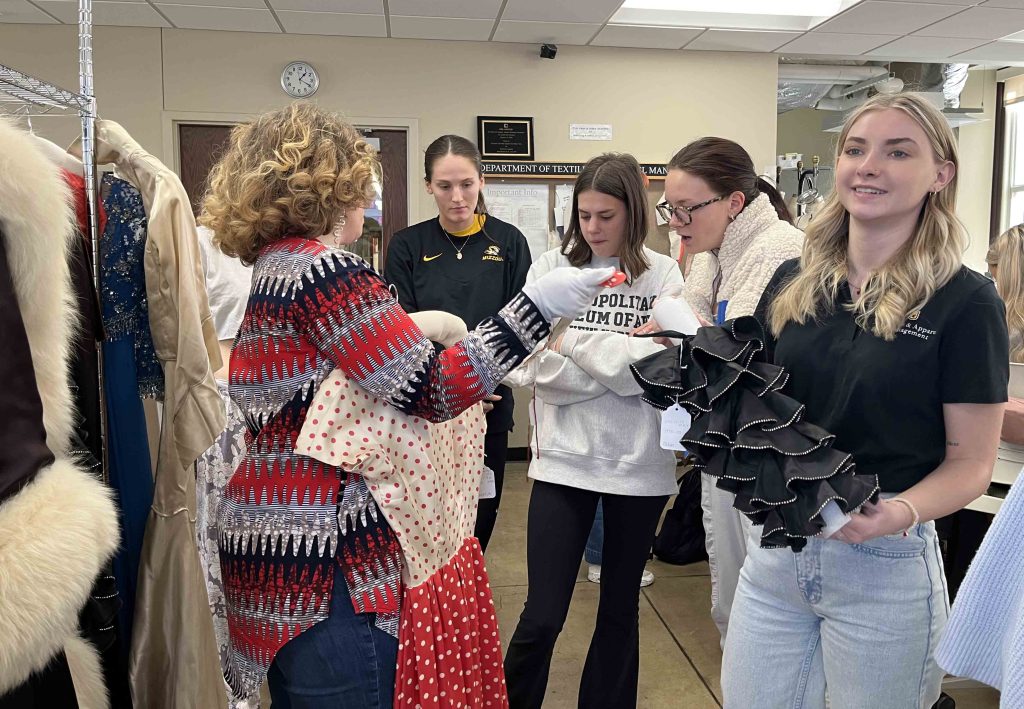
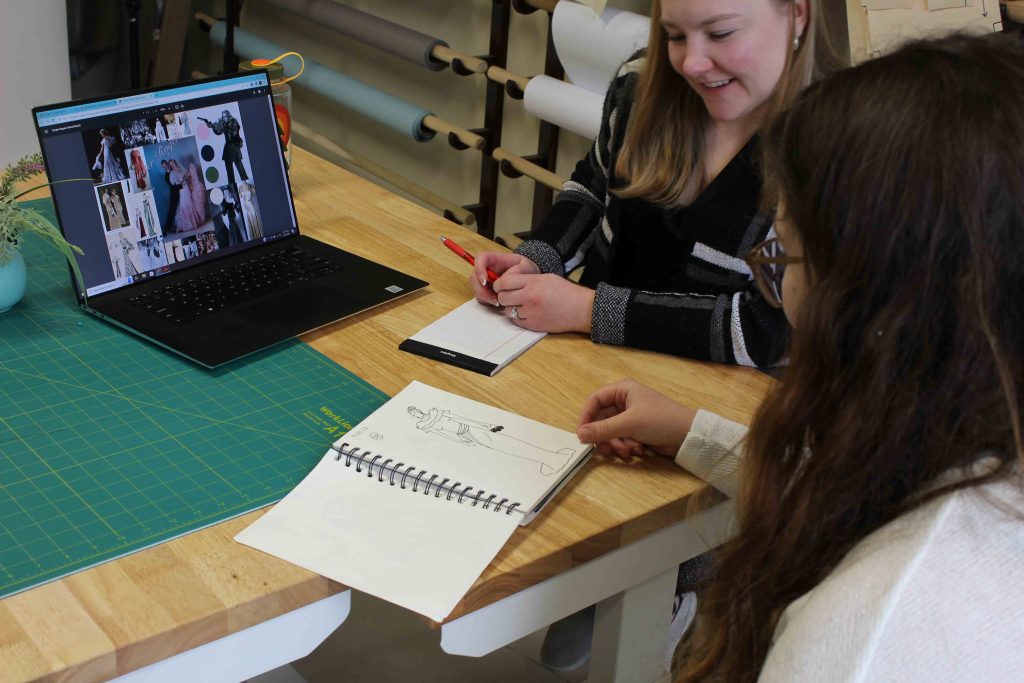
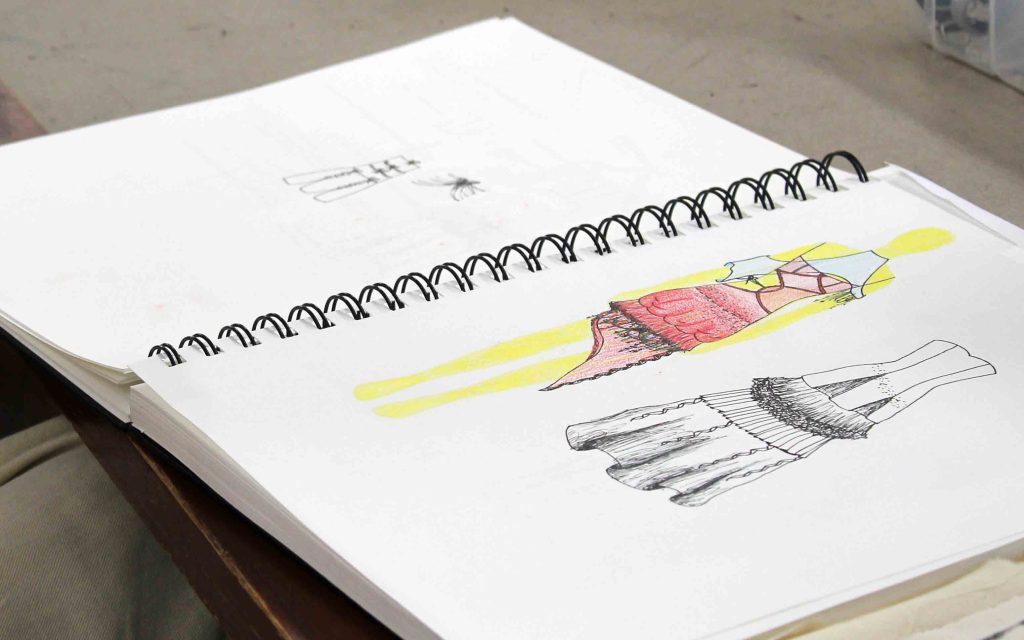
STEP 3: PATTERNMAKING
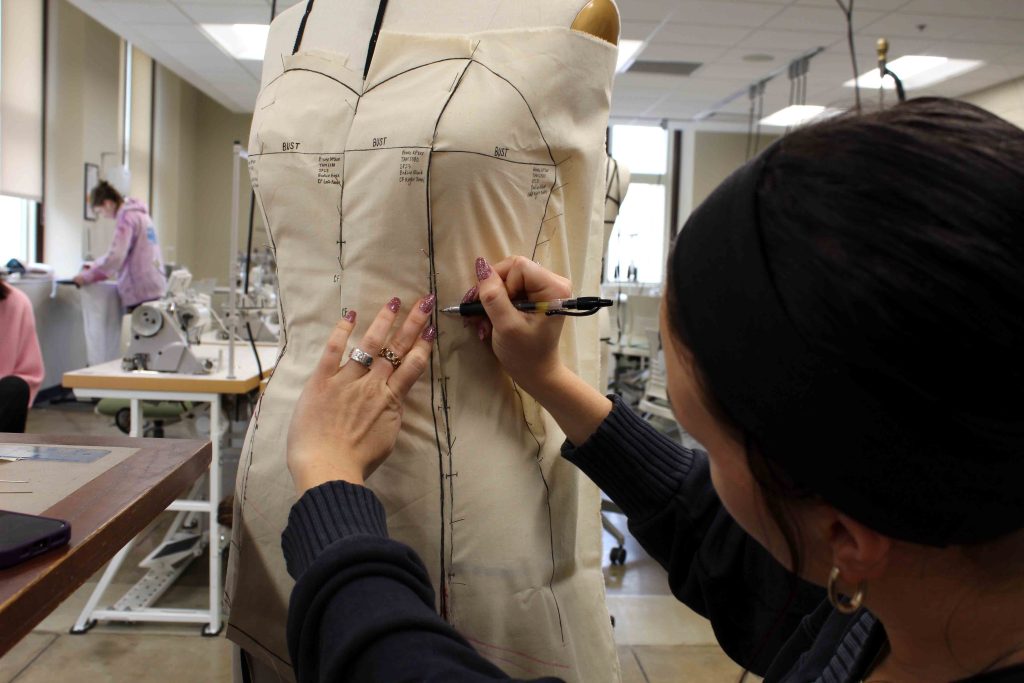
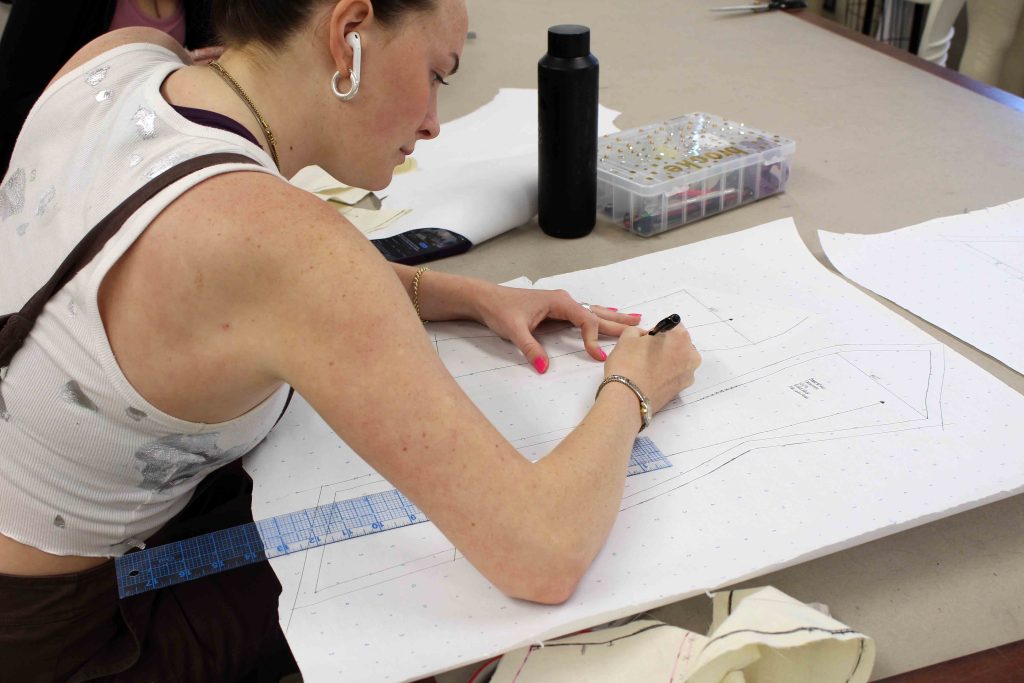
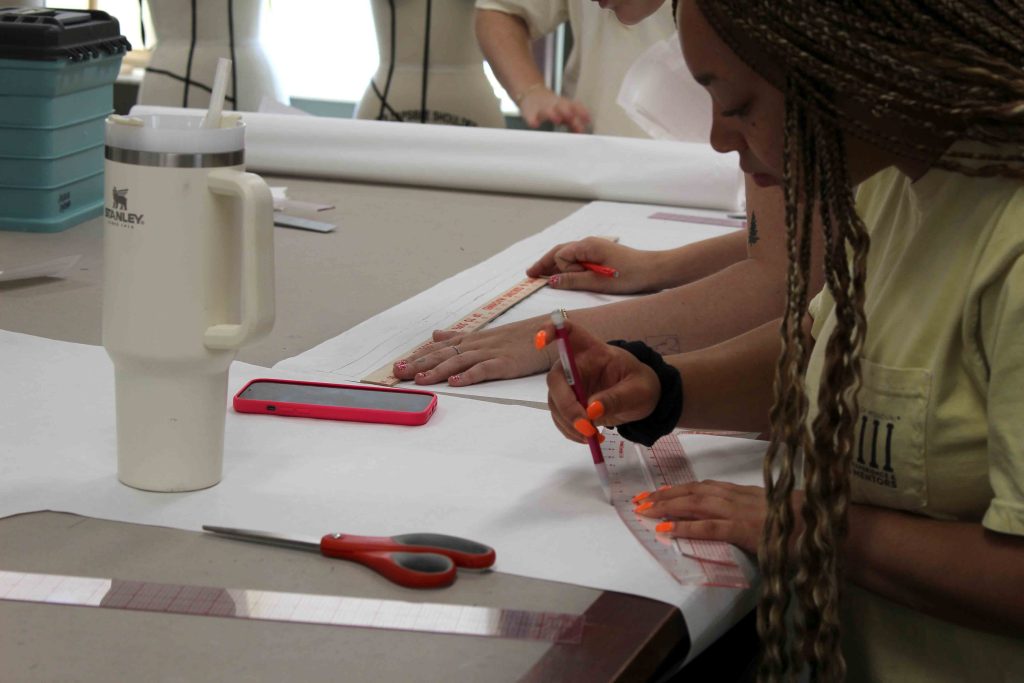
STEP 4: CONSTRUCTION



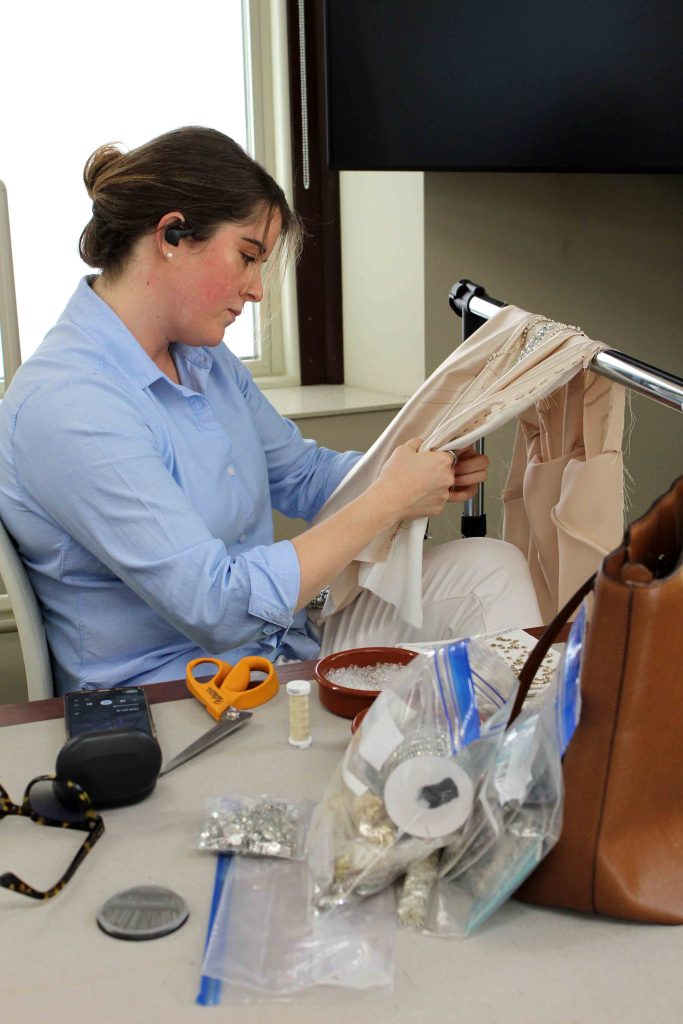
STUDENT DESIGN GALLERY
In alphabetical order: Rebecca Adams; Lauren Biritz; Grace Blanton; Sydney Brockman; Margo Brunner; Brynn Eubanks; Alexandra George; Kierra Jackson; Allison Keys; Alex Libman; Kaitlin Lyman; Brooke McKee; Jessica Ogboh; Alyssa Pierson; Hannah Retke
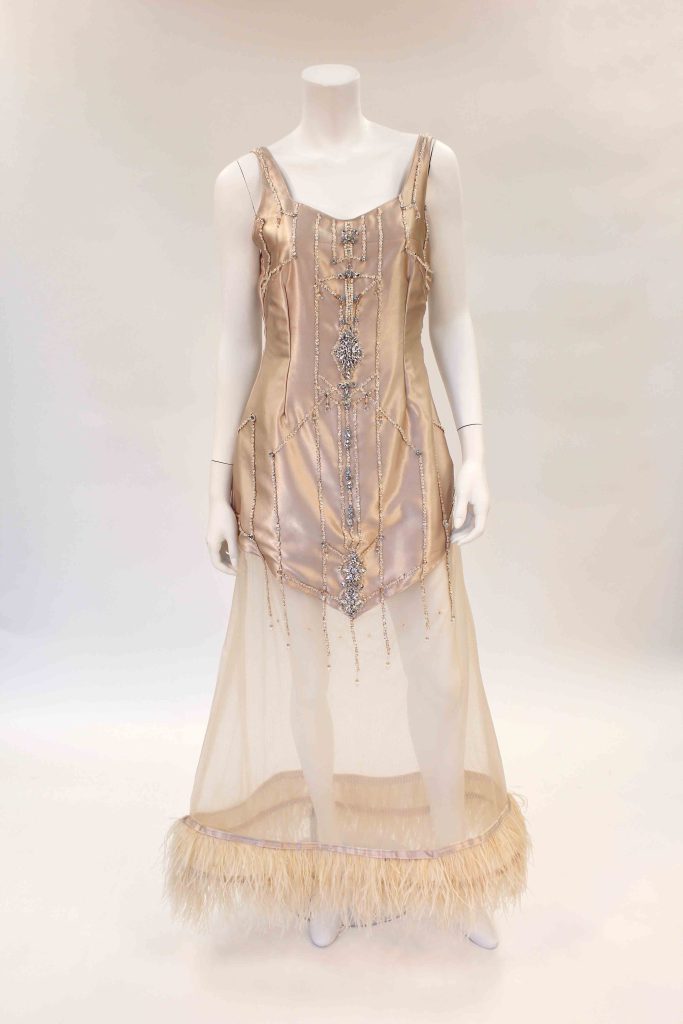
REBECCA ADAMS Hollywood Dream
“This Hollywood Dream evening dress was inspired by old Hollywood romance and crystal chandeliers. Hollywood in the 1930s was full of glamour, glitz, and beauty, and I wanted to create a gown that Ginger Rogers herself would have wanted to wear. I drew inspiration from her personal style as well as the many elements of design that were prevalent in that period. I wanted to create a garment that was art deco and captured the essence of 1930s glamour.
I was inspired by the beaded gowns of the 1920s, especially ones that were hand beaded by Mason Lesage, as well as the satin bias cut gowns that were popular in the 1930s. The dress is made from a champagne satin and layered sheer fabric, Czech glass beads, glass rhinestones, glass pearls, rose gold sequins, and ostrich feathers, all carefully selected to reflect the most amount of light possible and to promote luxury. Each bead, sequin and rhinestone was sewn and attached by hand, which was my first attempt at beading and tambour embroidery. There are hundreds of beads and sequins on the front of the gown, which took over 25 hours for the beading portion alone. The art deco pattern is my custom design and was inspired by wallpaper. It was designed specifically for this project, which I first mapped out on a poster board with my bodice pattern traced onto it.”

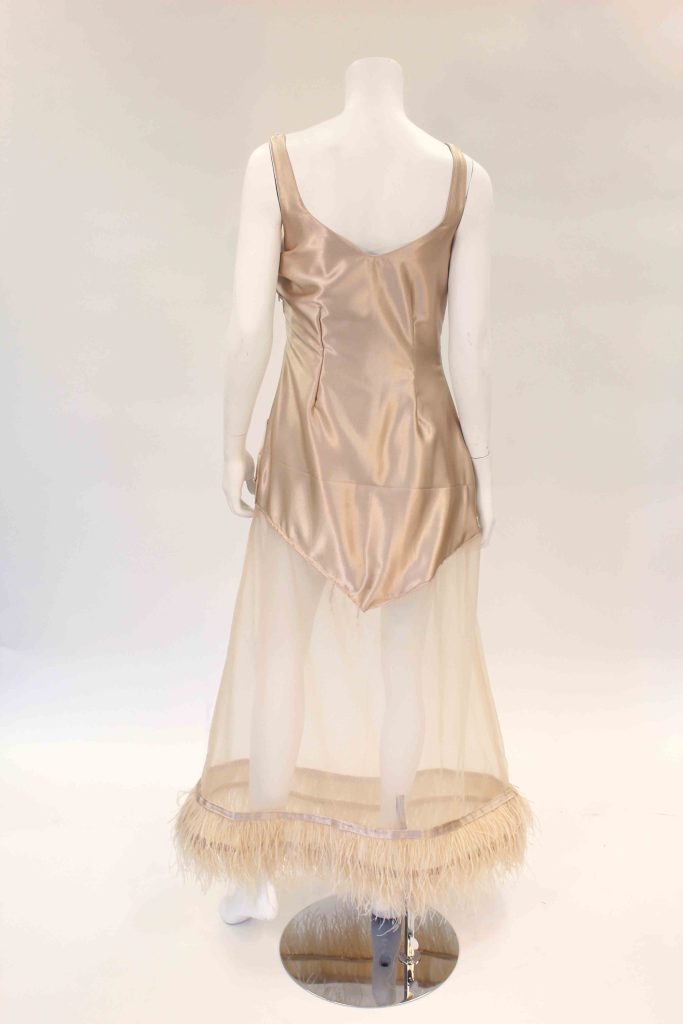
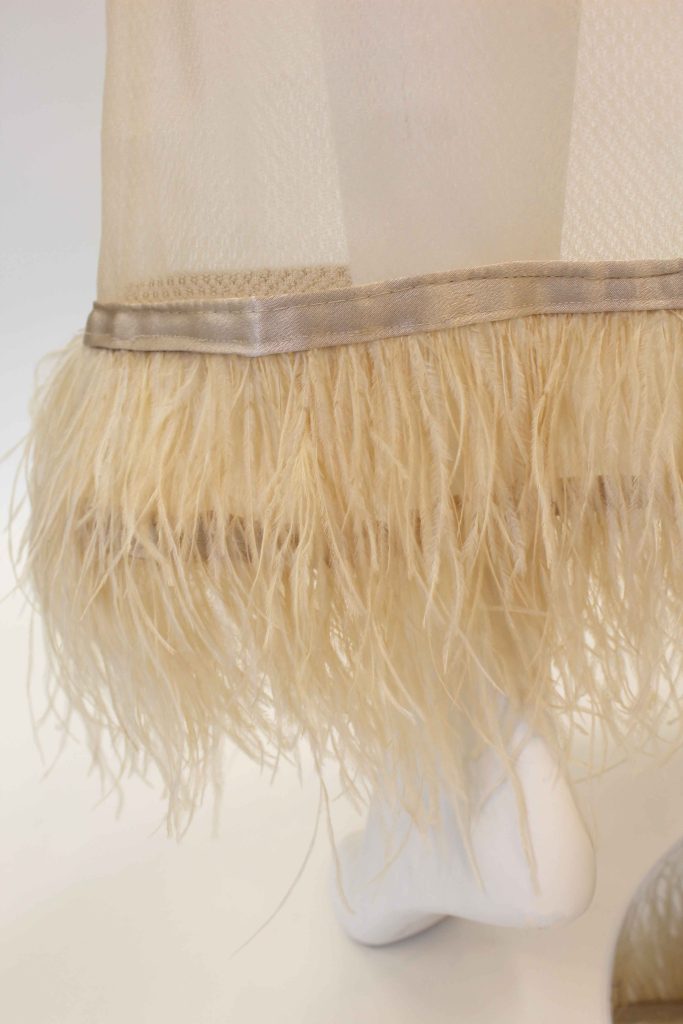

LAUREN BIRITZ Forever Female
“Ginger Rogers was an iconic dancer and actress known for her elegant, graceful and feminine style which was both glamorous and sophisticated. She had a timeless sense of fashion that was elegant and refined, yet also playful and flirty. She often wore dresses with intricate detailing, such as beading, sequins, feathers, or lace, that added an extra touch of glamour to her look. Overall, Rogers embodied the classic Hollywood style of the 1930s and 1940s with her timeless elegance and effortless charm.
This garment takes its name from the 1935 film “Forever Female” in which Rogers plays an ageing Broadway actress who is determined to secure the lead role in a play, despite being too old for the role. Some critics believe this movie became a “semi-autobiographical workshop” for Rogers where she could confront her own aging in an industry that values youth. As Rogers aged, she did struggle to find good roles, but her youthful spirit never went away. Her zest for life radiated from her and translated into her fashion choices, making her appear perpetually youthful regardless of her age. The gown ‘Forever Female’ truly elicits the feminine essence that was often the center point of Rogers’ style.”
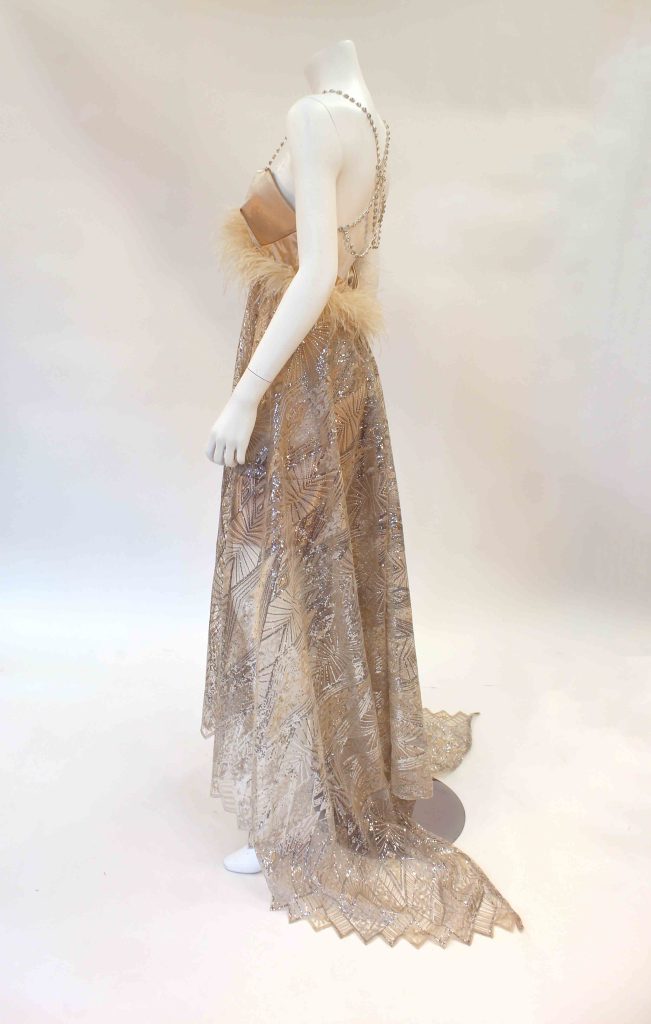
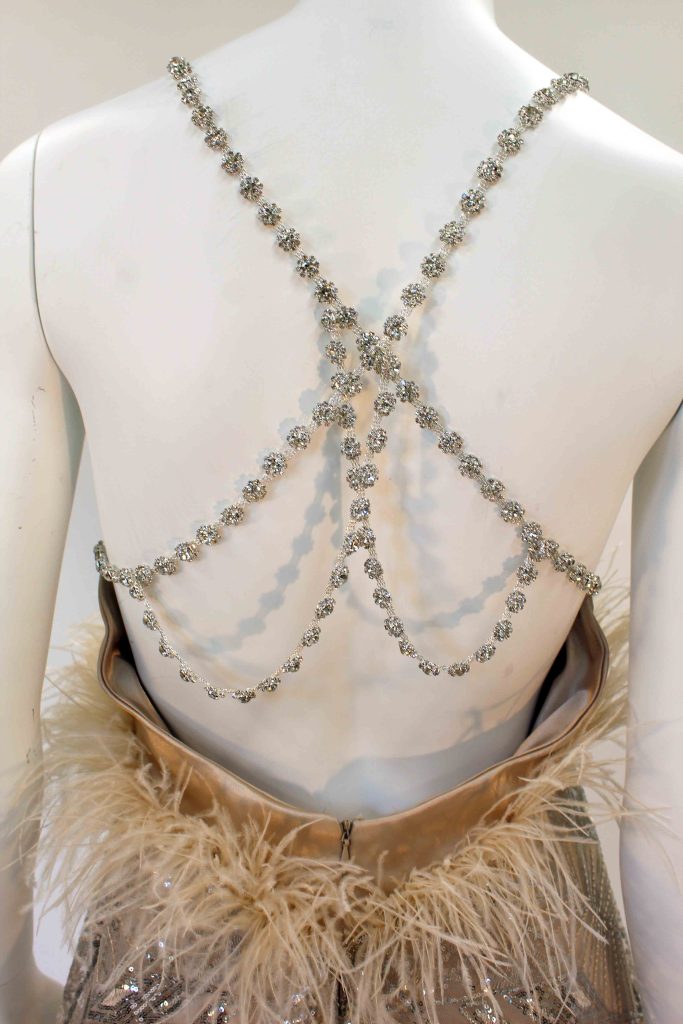
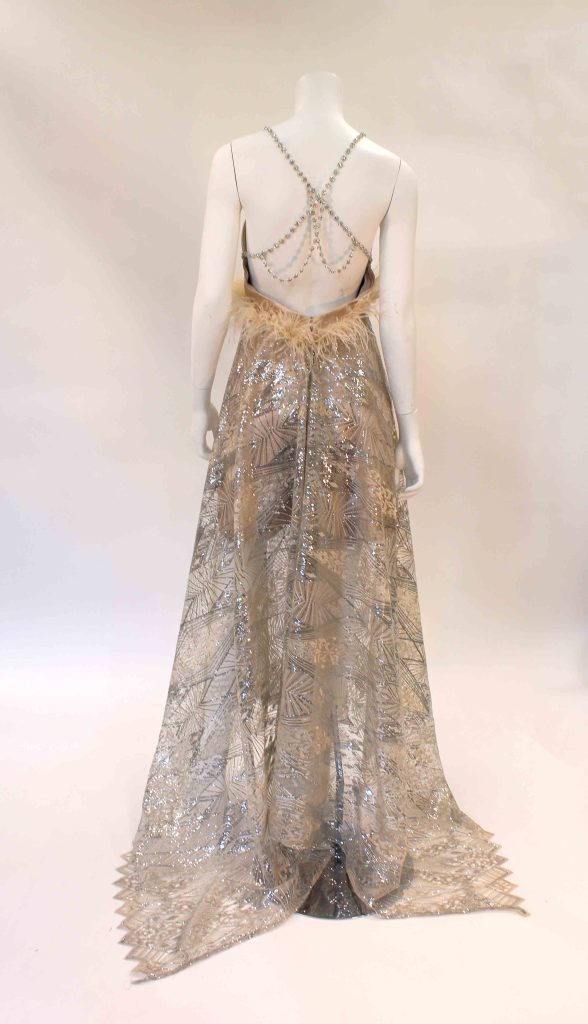

“‘Forever Female’ is also inspired by Rogers’ shimmering, dramatic yellow dress in “Swing Time” from 1936 which featured a fitted bodice with plunging neckline that highlighted her figure and a full skirt that fell to the floor in soft, flowing folds. The main fabric of the gown was a lustrous satin fabric with subtle Art Deco style and an embroidered and sequined over-skirt that caught the light, adding depth and dimension. A sweetheart neckline mimics the sweetheart shape of Rogers’ yellow dress, balancing clean lines and a minimalistic rhinestone embellishment. The intricate details in the skirt of ‘Forever Female’ add a touch of vintage glamour and elegance while its feathered waistline elicits the young feminine playful energy Rogers embodied and is a reference to Rogers’ stunning blue feather dress in the 1935 film “Top Hot.” Ginger Rogers truly is ‘forever female.’ This garment translates Rogers’ timeless Hollywood glamour into a dress fit to wear in more modern times.”
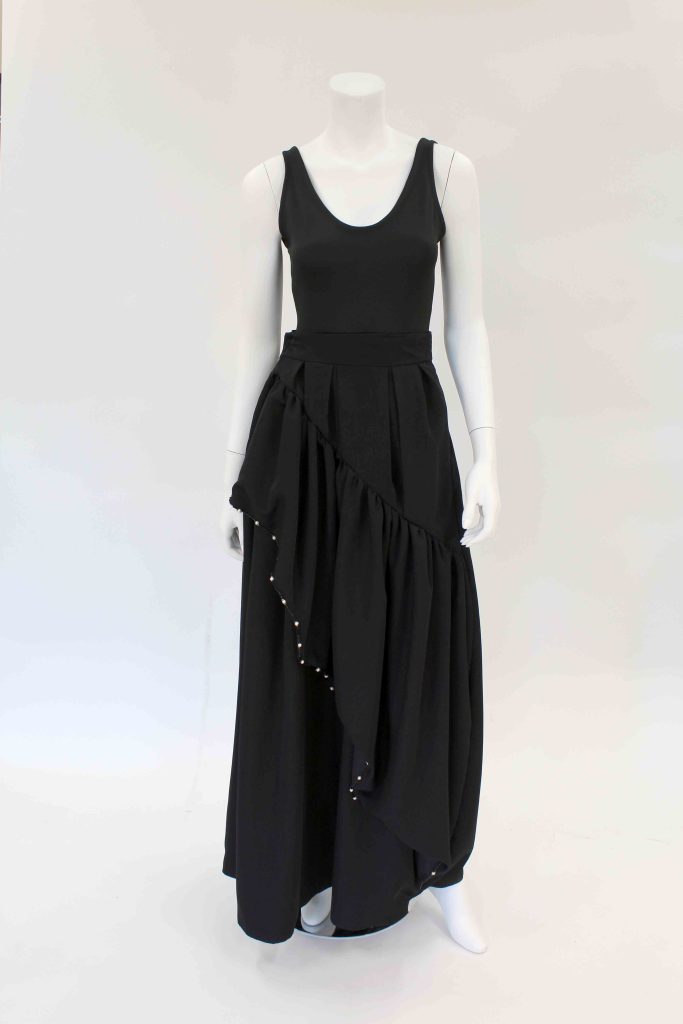
GRACE BLANTON Game, Set, Dance
“One of Ginger Rogers’ avid hobbies was tennis. She regularly participated in tournaments and even played in the 1950 U.S. Open Tennis Championships in the mixed doubles category with Frank Shields (grandfather of actress Brooke Shields.) This served as the main inspiration for ‘Game, Set, Dance’ which provides two different looks for the Hollywood star. The first is a knit tennis dress Rogers could have worn while playing tennis. The second is a wrap overskirt to wear for entertaining. The ensemble is an adaptation and interpretation of performance wear from the 1930s and a vision of what Ginger Rogers would wear today. The look is elegant yet playful to enhance the movements Rogers would have performed on stage.
‘Game, Set, Dance’ represents an elegant and timeless approach to a transformational ensemble. Keeping in mind the garment needed to provide two different looks, balance and emphasis were two important elements to consider. Its black color enables the garment to transition seamlessly from daytime’s tennis dress to an evening ensemble by adding an overskirt with hand-sewn imitation pearl trim. This garment is a new take on Rogers’ lifestyle that pushes the envelope of performance wear.”
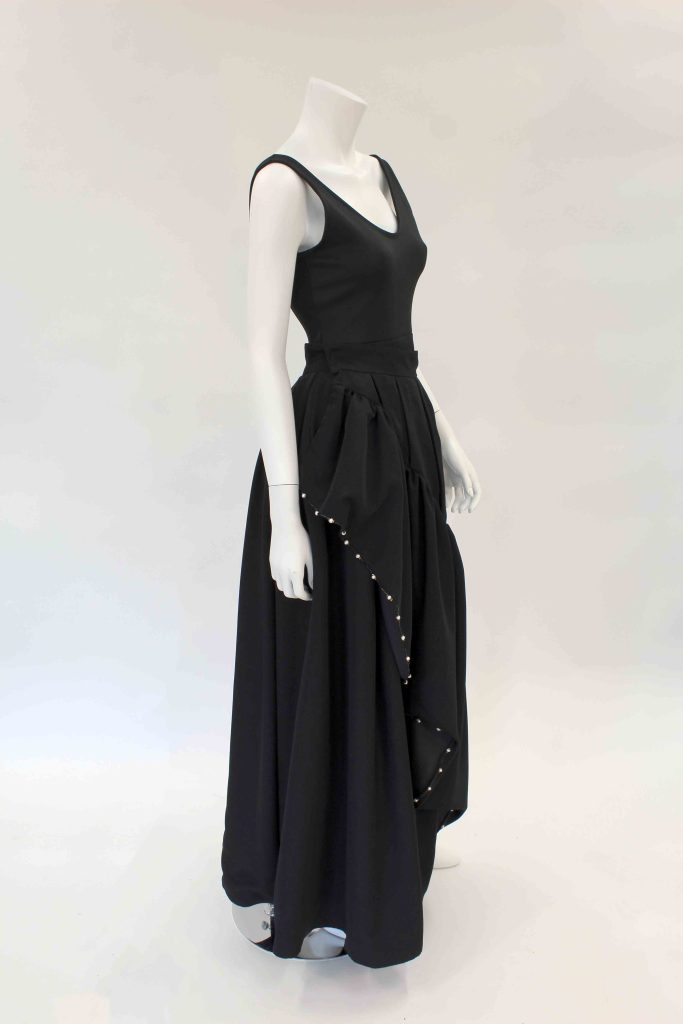
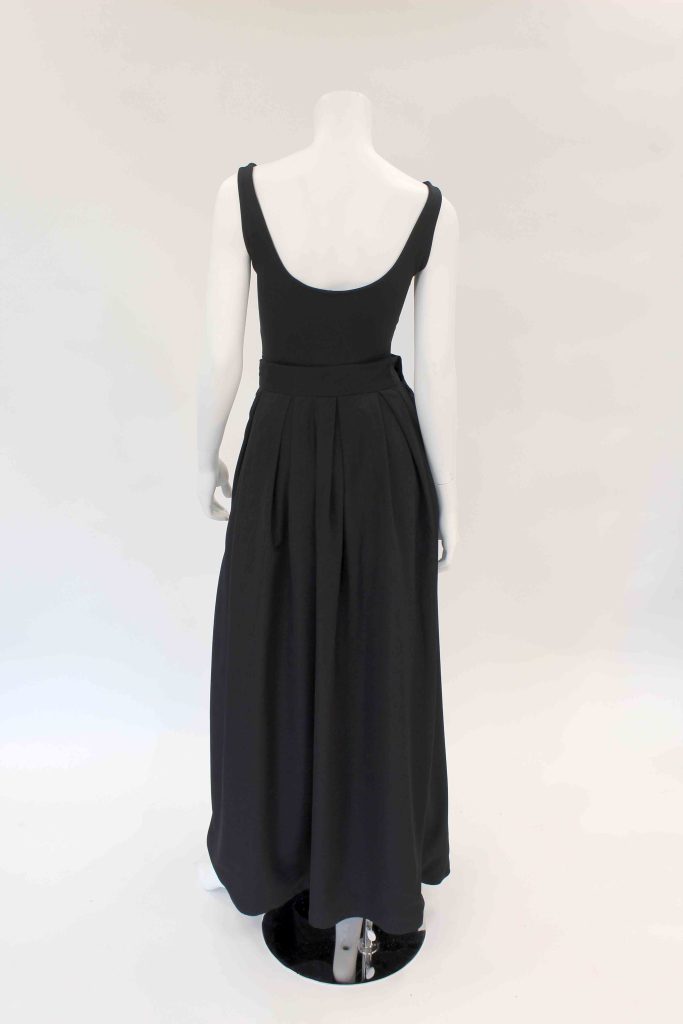
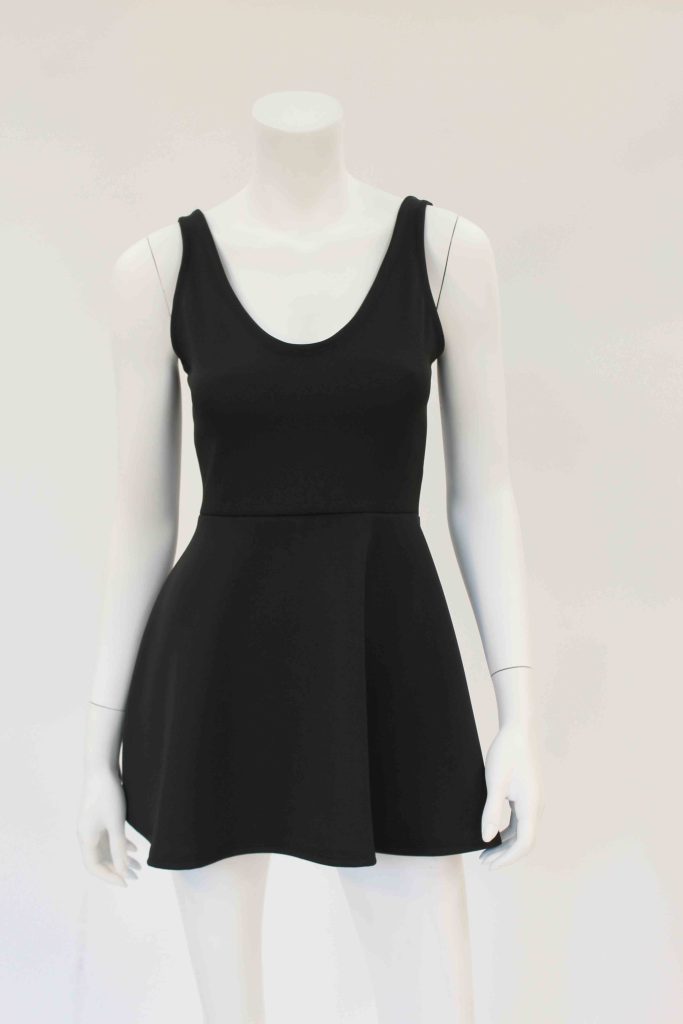
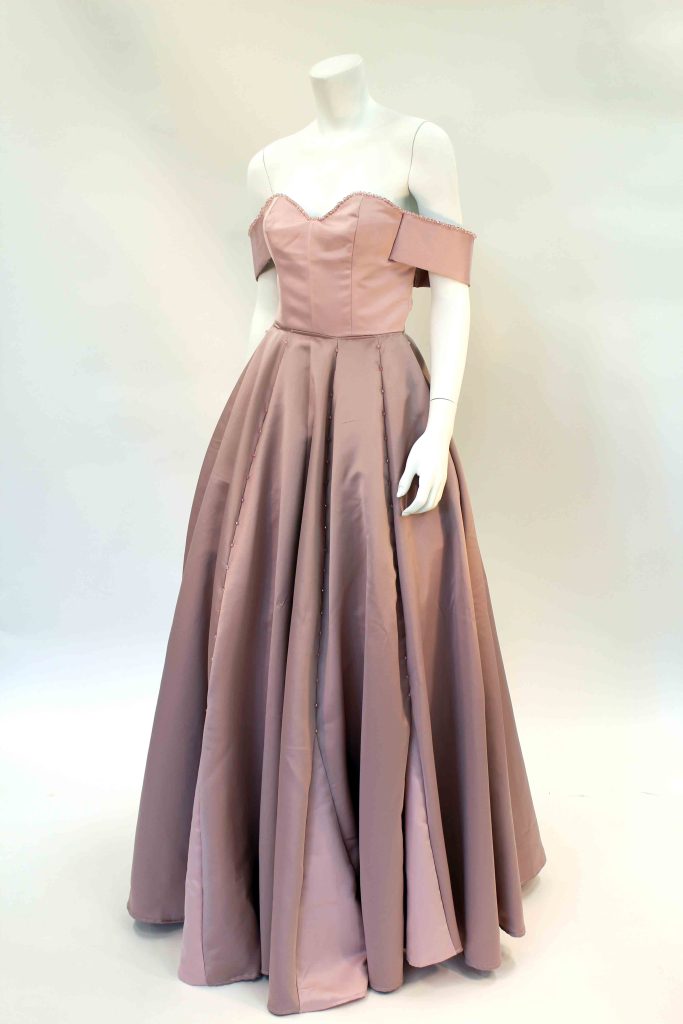
SYDNEY BROCKMAN Blushing Rosette
“As Rogers’ career progressed, she became synonymous with the gowns she wore while dancing, long flowing dresses adorned with rhinestones, as well as extravagant costumes with big frills, beads and feathers. The elegant glamour of Hollywood and Rogers’ significant presence in entertainment and fashion set the tone for this garment. The objective of ‘Blushing Rosette’ was to incorporate inspiration from Rogers’ dance costumes and the 1930s bouffant silhouette into an elegant glamorous gown in which Rogers herself would have performed.
The dress took inspiration from the long, flared gown Rogers wore in “Swing Time” (1936) that featured multiple panels sewn together for the skirt which added extreme flare and movement. This garment inspired the skirt panels in ‘Blushing Rosette.’ Popular in late 1930s evening wear, the bouffant skirt adds body to the waist and hips; a three-tiered tulle petticoat was also designed to exaggerate the fullness and provide support. Rogers’ favorite color pink inspired the two fabrics chosen for the bodice and skirt design. Hand-beaded pink crystals on the neckline and skirt seamlines add sparkle and glamour to the gown under performance lights. The combination of each design element makes ‘Blushing Rosette’ unique and elegant while paying home to the late performer.”
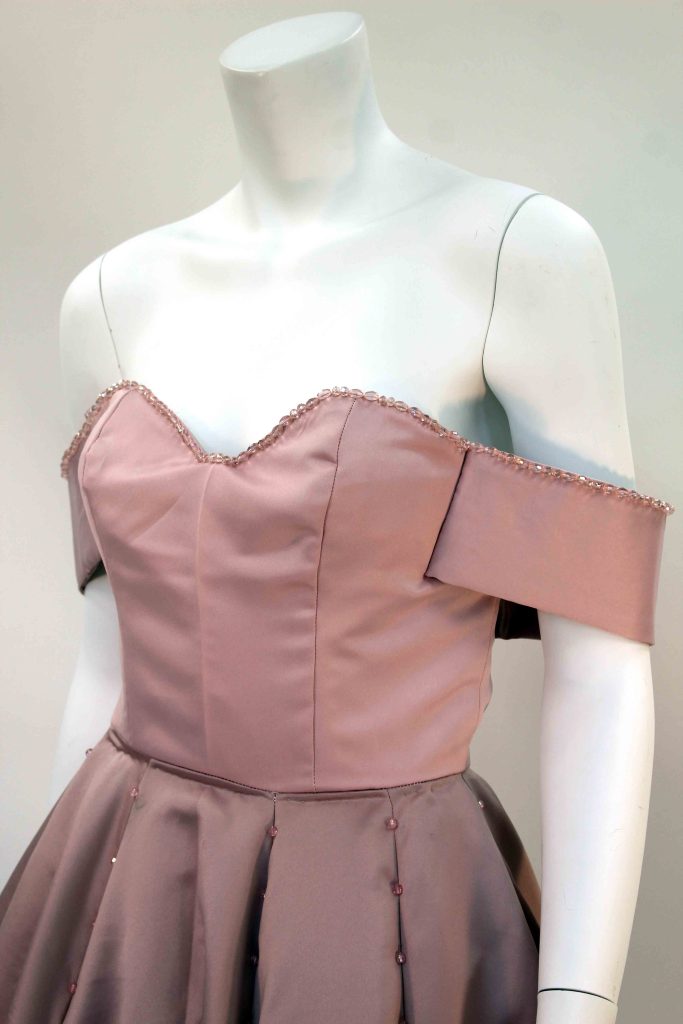
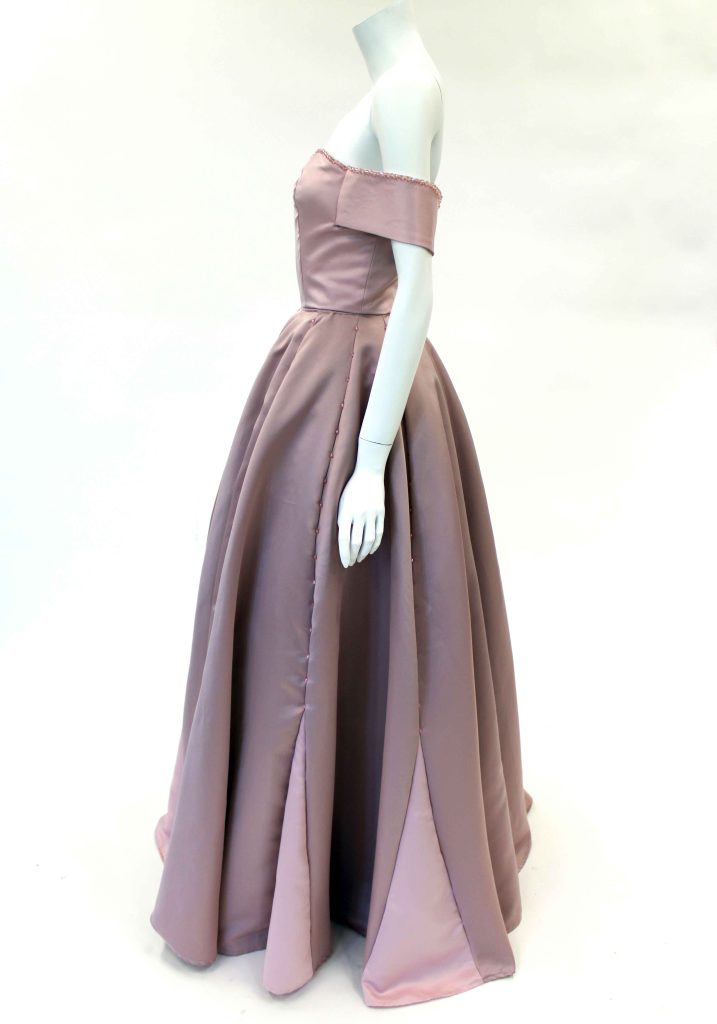

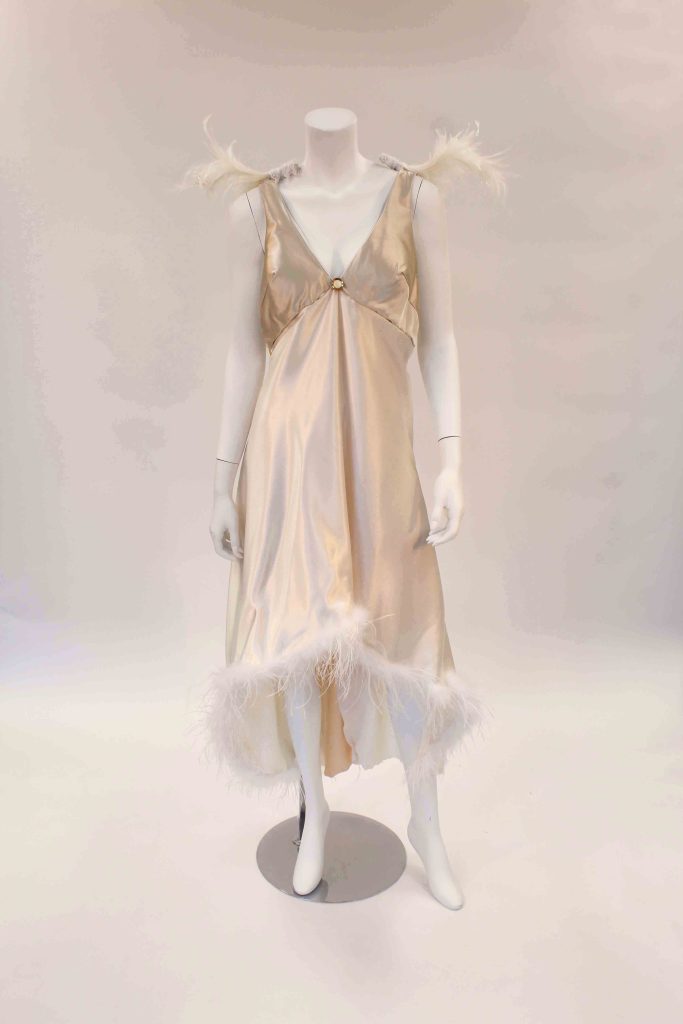
MARGO BRUNNER Golden Angel
“Ginger Rogers, a dancer and actress, was known for her bold choice of dress. For more visual fluidity and flash during her performances, especially in the 1930s, Rogers wore glamourous bias-cut dresses that moved along with her while she danced and grabbed the attention of the audience. ‘Golden Angel’ refers not only to the significance of her popularity during the 1930s Golden Age of Hollywood, but also the color pallet and the way her dresses flowed when she moved, almost like an angel. A very consistent style Rogers wore included a sleeveless bodice with a V-shaped neckline which led to my beginning silhouette followed by her use of feathers and other embellishments. At its core, the inspiration for ‘Golden Angel’ comes from Elsa Schiaparelli’s designs of the 1930s and her particular use of classic champagne shades and minimalistic flowing silhouettes. These decorative features directly relate to Rogers’ consistent use of feathers and eye-catching embellishments that flowed with the movement of her performances. The mix of movement and reflection of celestial hues, a soft presentation, and small gold and pearl details in ‘Golden Angel’ create a sort of ethereal and blissful design. Its high-low skirt creates even further movement with ostrich feathers that lay much like a cloud.”
“The bias cut was necessary in order to create the drape and flow that was crucial to properly portray the initial inspiration. This technique additional results in less textile waste. The desired outcome was a delicate, sweeping dress drawn from the relation between feathers and angel wings, loosely depicted through feathers on both shoulders.”
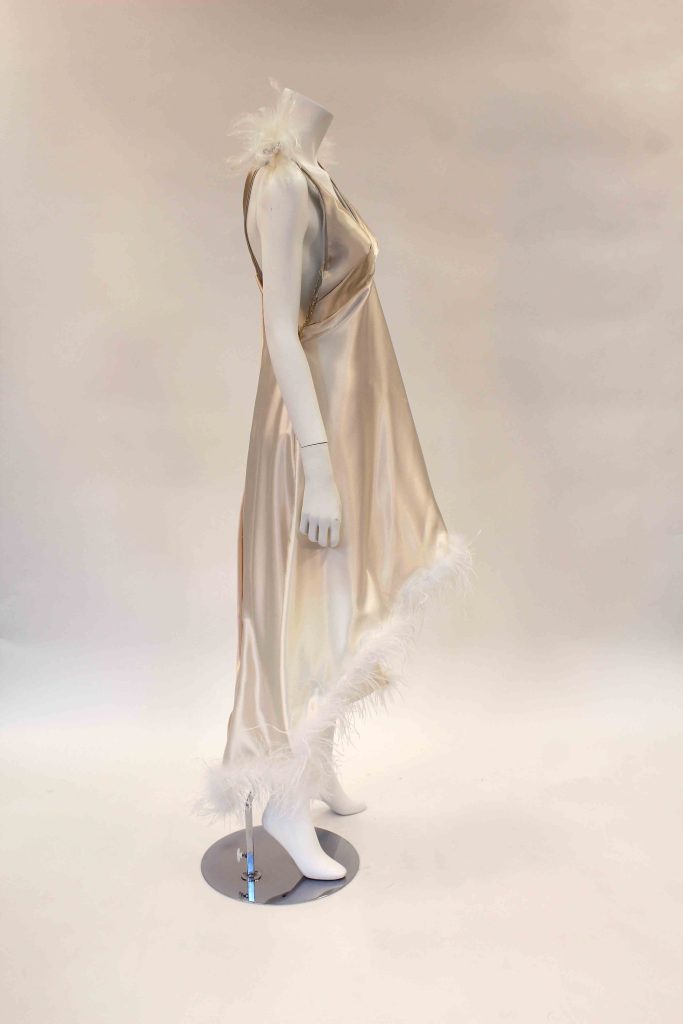
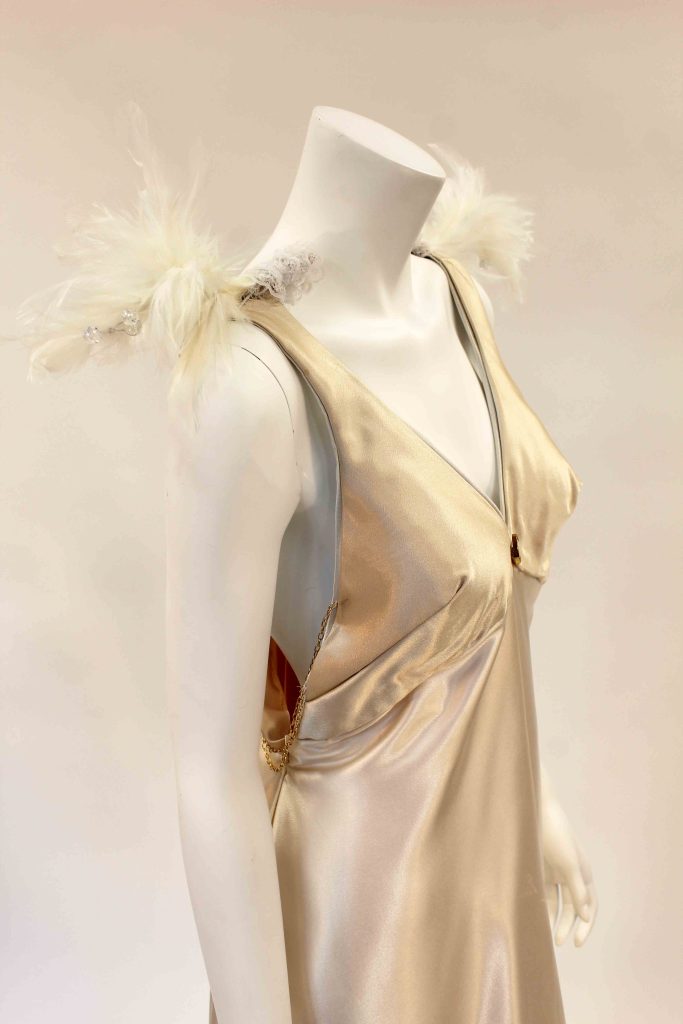

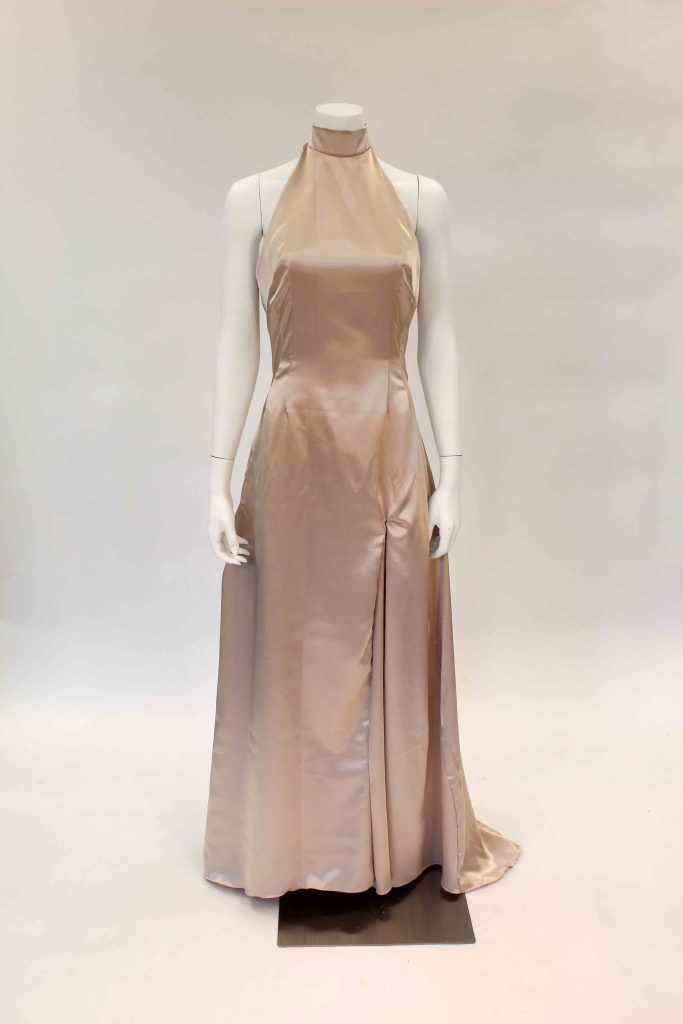
BRYNN EUBANKS Pearlescent
“Ginger Rogers embodied the confidence and femininity to which every woman aspired. She inspired many designers and stylists of past and present; for me, ‘Pearlescent’ reflects Rogers’ personality with a modern twist to express a look of the 1940s. The decision to create a flowing dress with opening slit down the leg was based on Rogers’ dancing and singing in many of her films. Lines of champagne-colored pearls highlight an open back back to create a feminine look. The gown’s ivory satin shimmer reflects Ginger’s look that was always sparkly but very classic.”
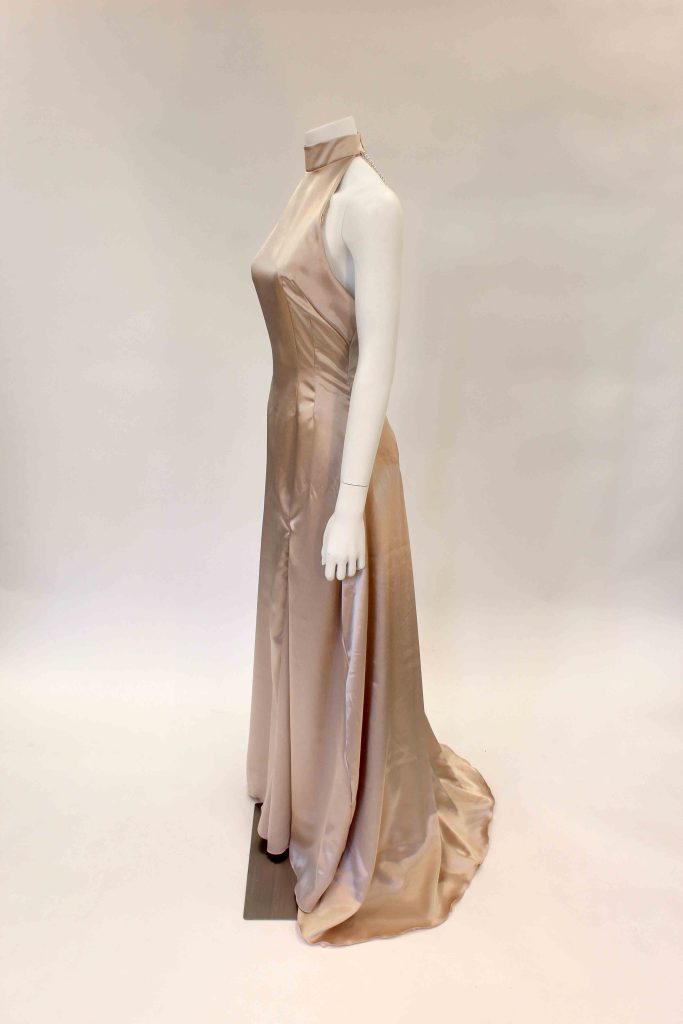
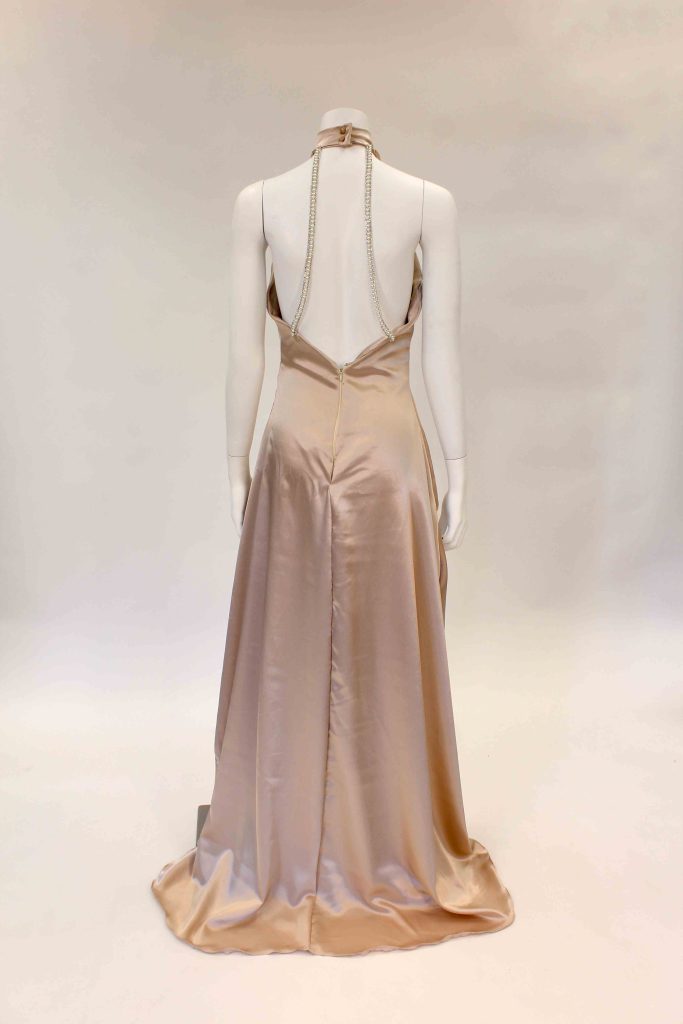
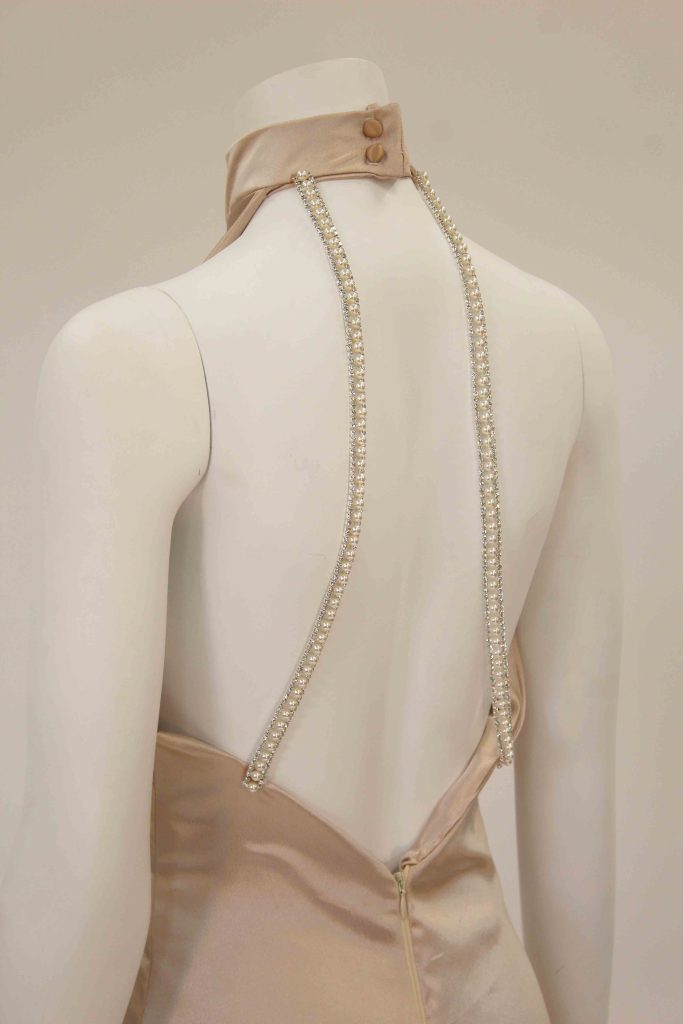
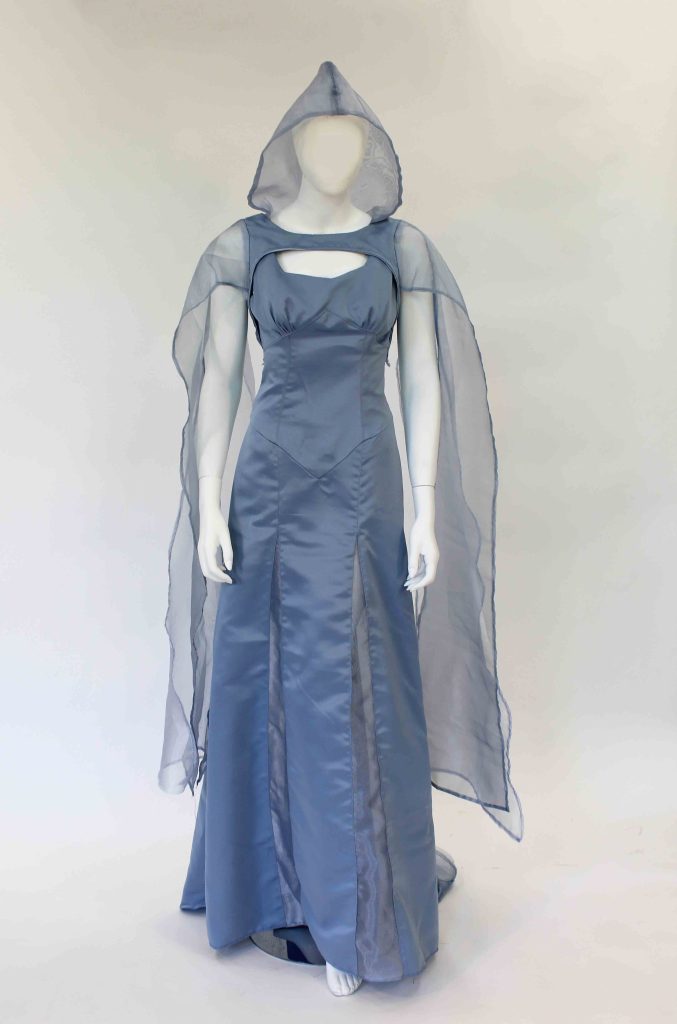
ALEXANDRA GEORGE Butterfly at Dusk
“Research on Ginger’s aesthetic revealed modular looks and flowing fabrics that twirled with her has she danced. Inspired by Ginger’s favorite movie, ‘Swing Time’ from 1936, this ensemble is meant to remind the viewer of Ginger’s later years when still worked to entertain and looked amazing while doing it. It aims to generate intrigue and excitement, two emotions Ginger conveyed well on screen. Glimmering organza sleeves and gores shimmer to represent the lights under which she danced. A hooded cape adds drama; sleeves of light organza billow out behind the wearer when they walk, creating the illusion of floating on air. Adding to the light, airy aesthetic of a butterfly fluttering at dusk are the 23-inch organza inserts touching the waistline and ending in a curved train at the back hem of the skirt. The torso’s pointed seamlines and dropped waistline were inspired by the 1930s when Ginger’s fame was blossoming. Ginger’s success was a result of talent and determine, two qualities that are necessary when sewing a complex garment like ‘Butterfly at Dusk.’ The dusky blue represents the conclusion of Ginger’s life as a twentieth-century icon.”
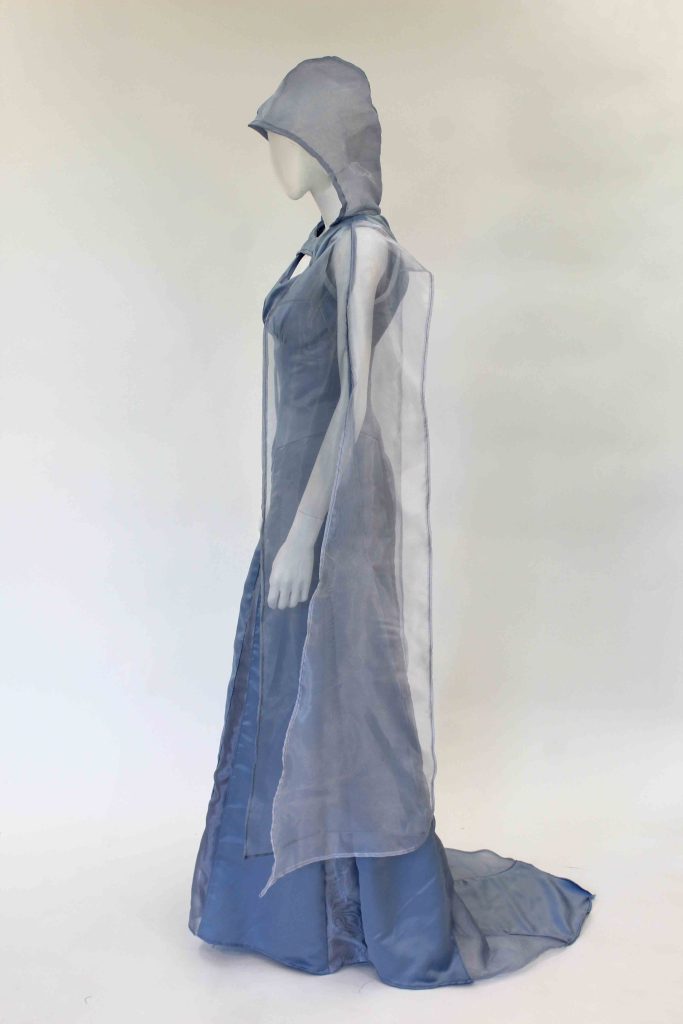

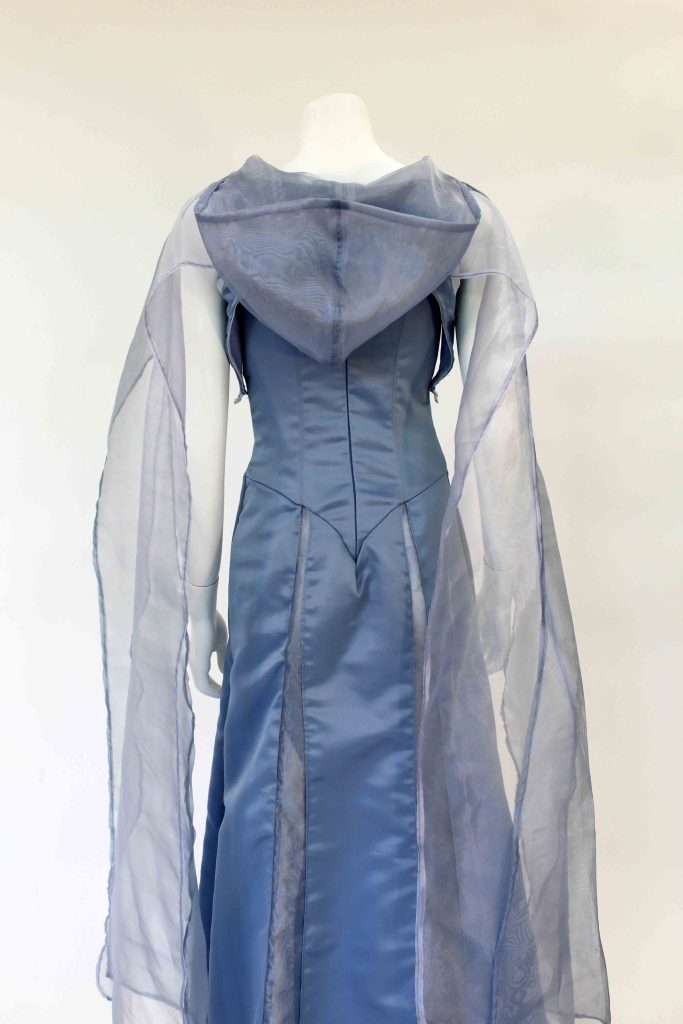
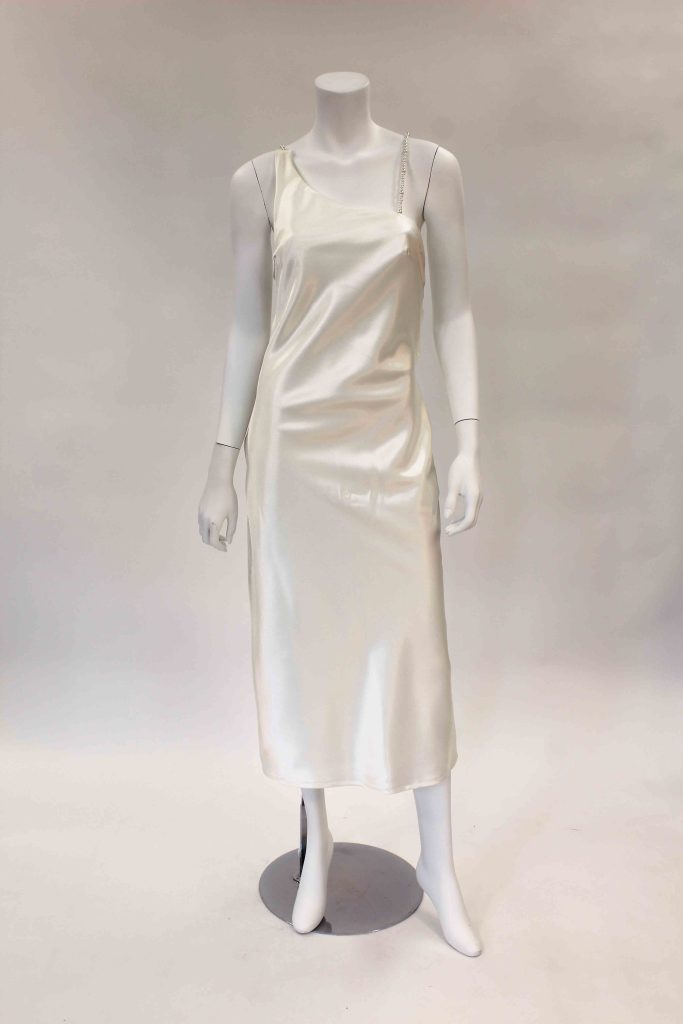
KIERRA JACKSON ‘I Do’ It All
“French designer Madeline Vionnet popularized the use of the bias cut – cutting fabric at a 45-degree angle – throughout the 1910s and 1920s. The bias-cut dress continued to be a trend in the 1930s during the Golden Age of Hollywood. Ginger Rogers rose to fame during this period, esteemed for her singing and dancing. The outfits she wore were often very extravagant with lots of movement, many of which were created using the bias-cut technique.
Rogers was a very versatile, multi-talented performer married five times throughout her life. This led to additional inspiration for the ‘I Do’ It All’ dress which is a one-shoulder, bias-cut wedding gown in a simple slip dress style. The concept of the ‘I Do’ It All’ dress is to combine inspiration from Rogers’ life to create a modern, versatile bridal gown that can be used for various formal events. Its slim, slinky silhouette allows for mobility and practicality, while a sweeping back cowl and hand-beaded pearl strap provide enhance the gown’s uniqueness.”
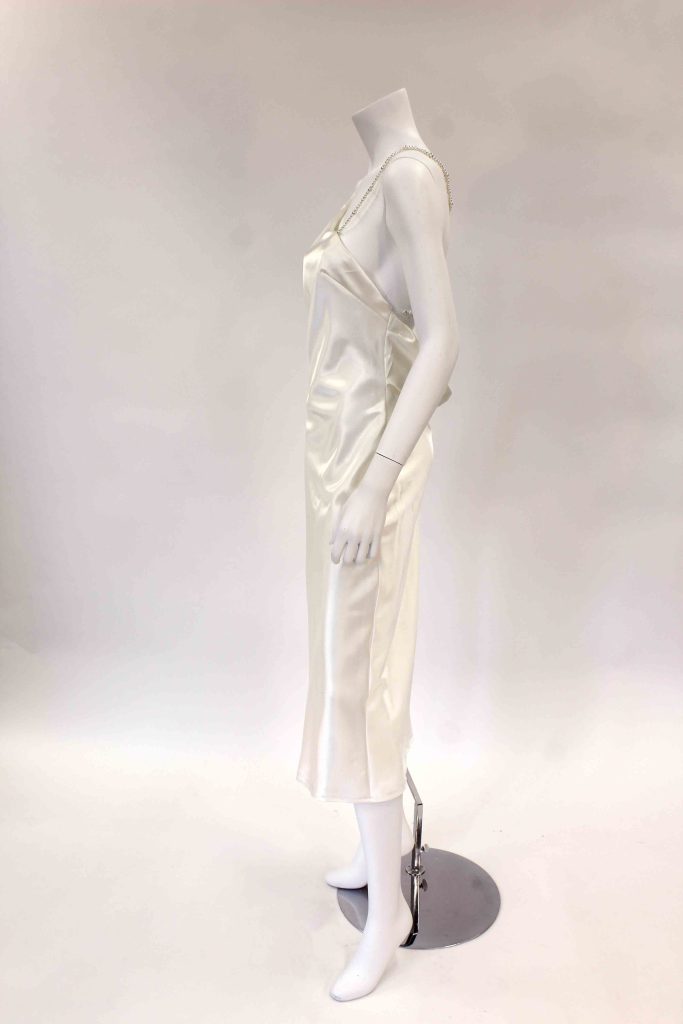
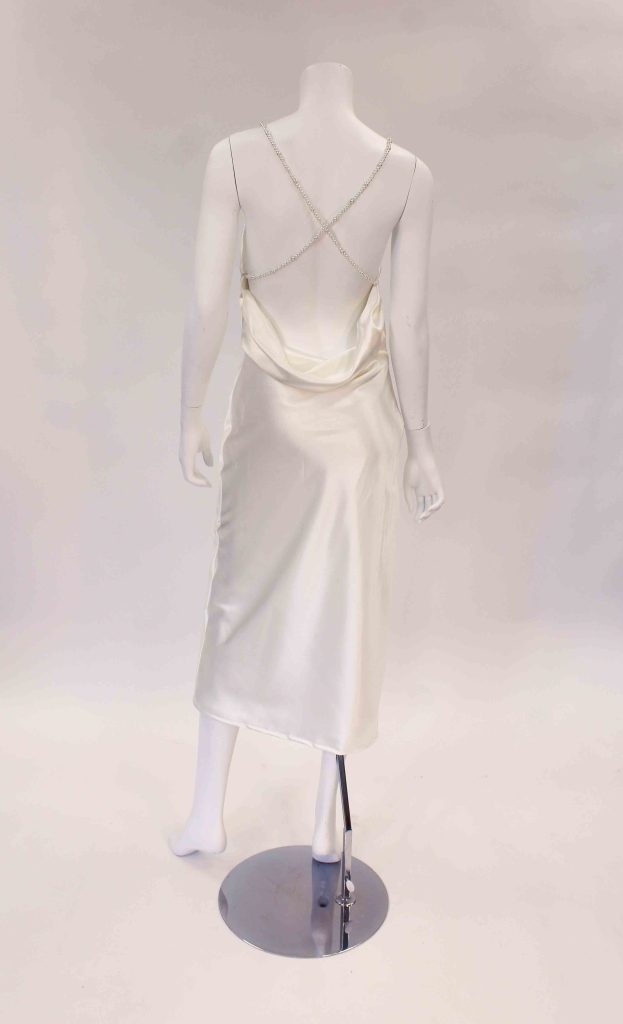
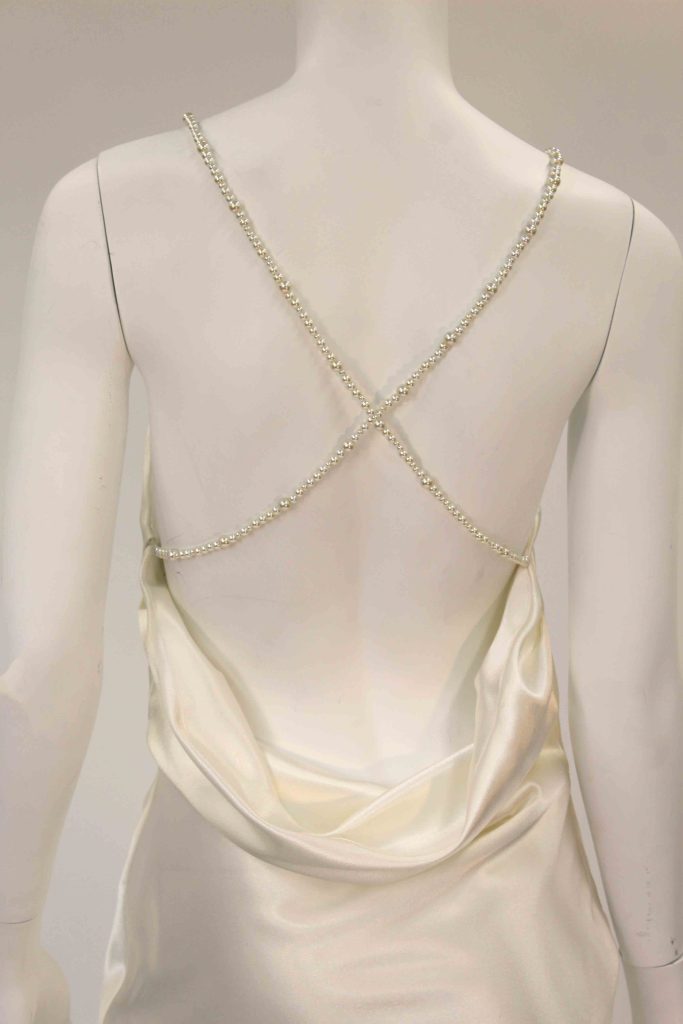
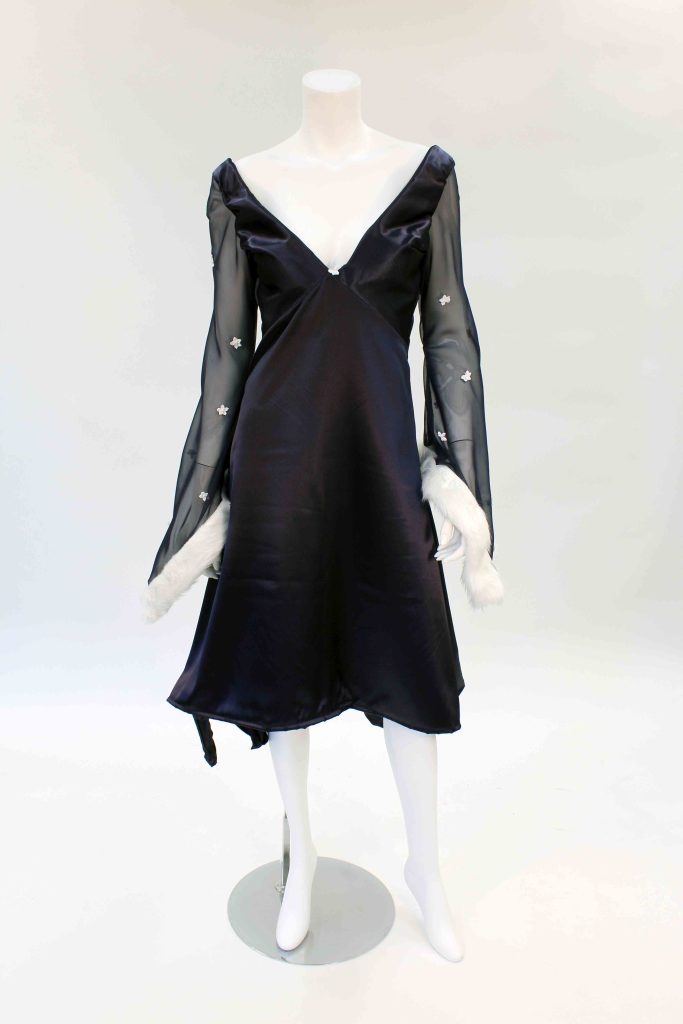
ALLISON KEYS Midnight
“Inspiration for ‘Midnight’ is taken from the low V-shaped neckline of Rogers’ 1936 “Swing Time” dress, her famous mink and sequin ensemble from “In the Dark” (1944), and my own perception of her personality through research and analysis of her fashion sense and style. I was able to incorporate parts of her playful personality that I saw as her true form. Many of her gowns from the 1930s were long and elegant ball gowns while others featured flared sleeves and mid-length hems. Still others were eccentric with ostrich feathers and mink fur. I chose faux fur trim over Ginger’s beloved feathers and scattered white flowers with pearl centers throughout the flared sheer sleeves for additional glamour.
The navy-blue satin fabric pays homage to a specific navy-blue satin dress made for Rogers by her mother, Lela Rogers. Mixed with the sheer organza of the sleeves, ‘Midnight’ emphasizes Rogers’ elegance and unique flare with a hint of playfulness to truly capture her sparkling personality.”

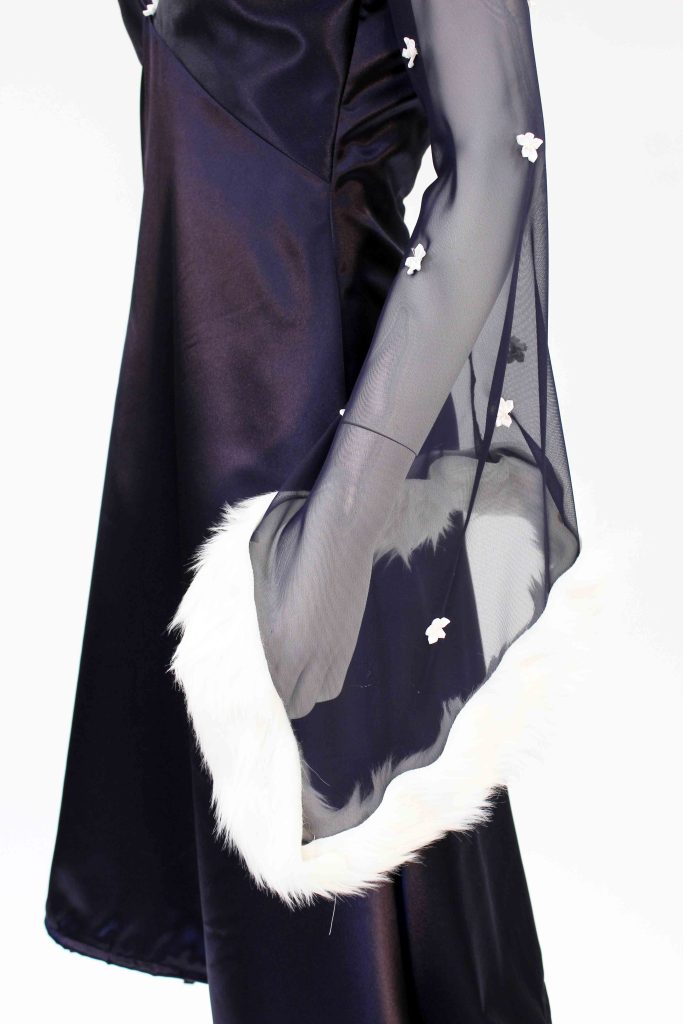
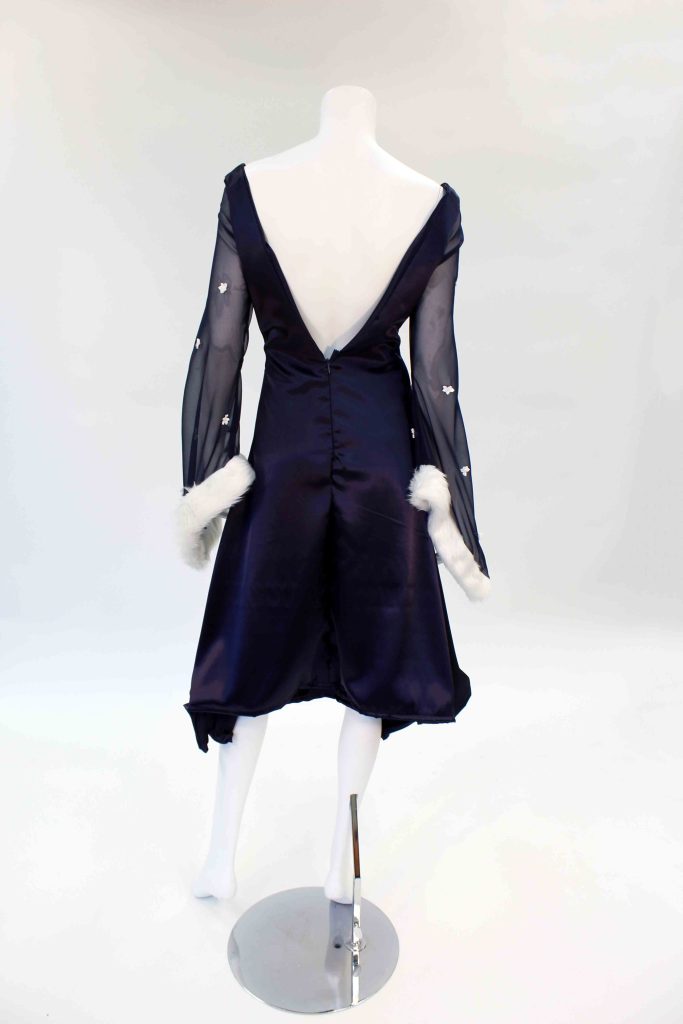
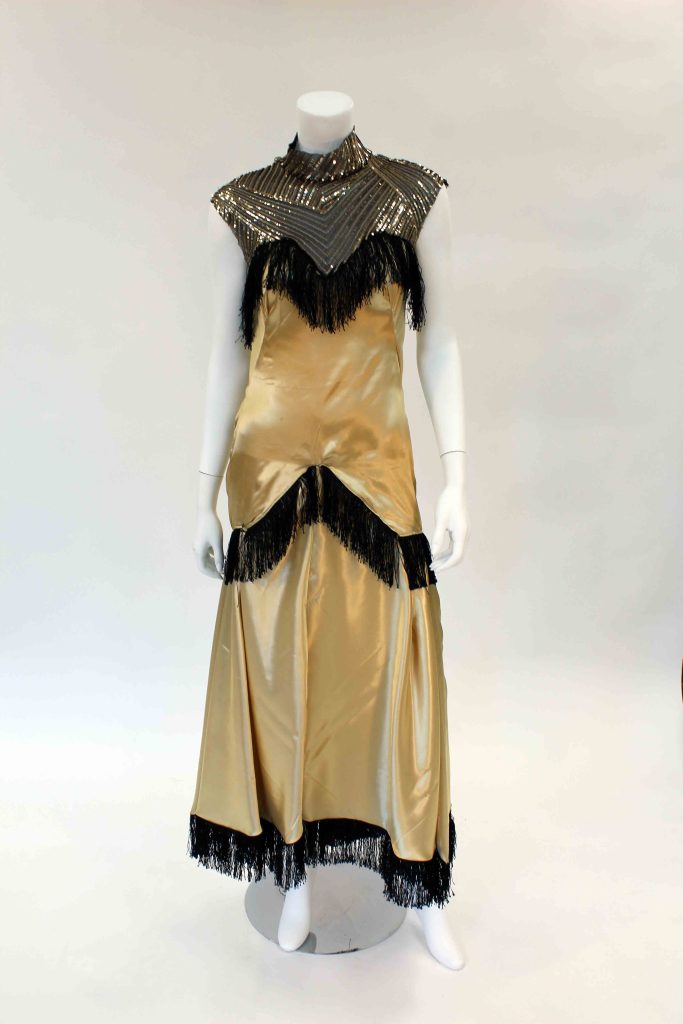
ALEX LIBMAN Glitz and Glamour
“Ginger’s fashion style incorporated feathers, glitter, flare, and triangular aspects that were included in a very unique way during the 1930s. The purpose of designing ‘Glitz and Glamour’ is to highlight her impact on fashion through 1930s details and incorporate modern details for women of today. The garment features box pleats at the bottom to create a large amount of flare for movement while dancing; being a dancer played a huge role in the way Ginger dressed, incorporating different types of pleats and gathers for flare. The design aims to highlight various elements of her dress, including bold necklines, v-cuts and the additional flare, and features a form-fitting silhouette, cowl back, angled and curved darts, and various types of fabric to create a show-stopping look. The final look accentuates her curves while allowing for movement in the skirt and fringe to design a more dramatic look when Rogers dances. The dress serves as a tribute to Ginger Rogers and her iconic dress practices.”
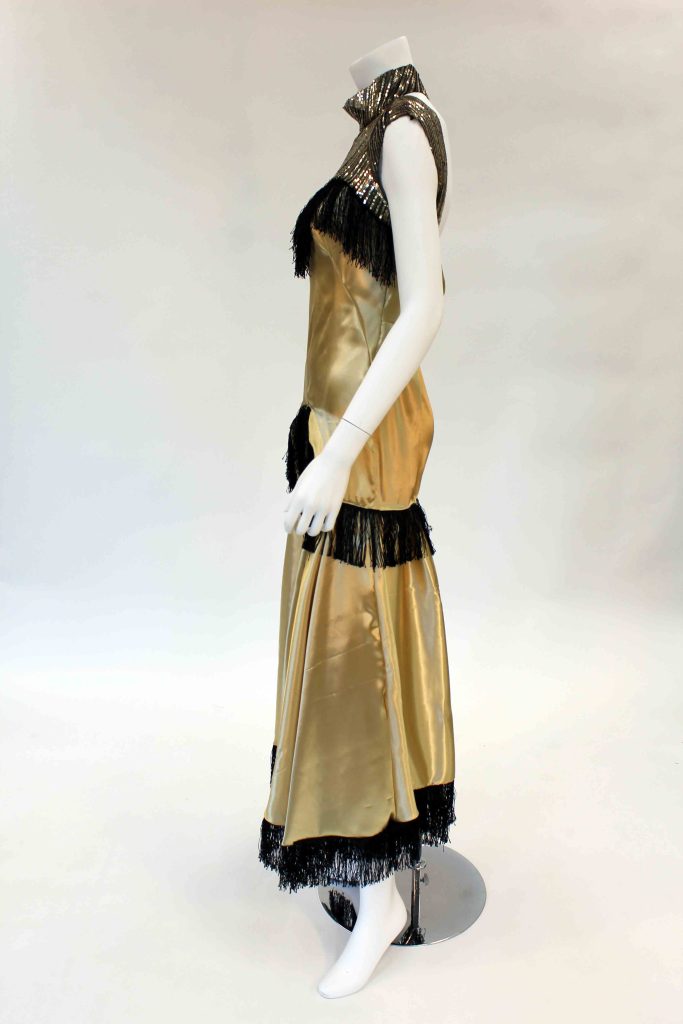
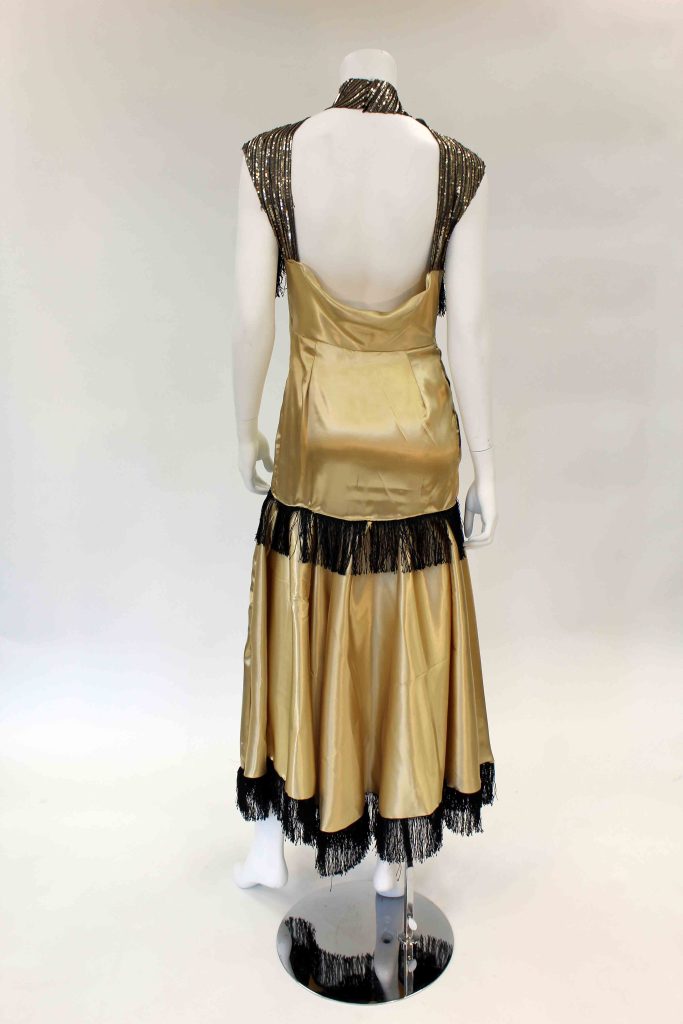
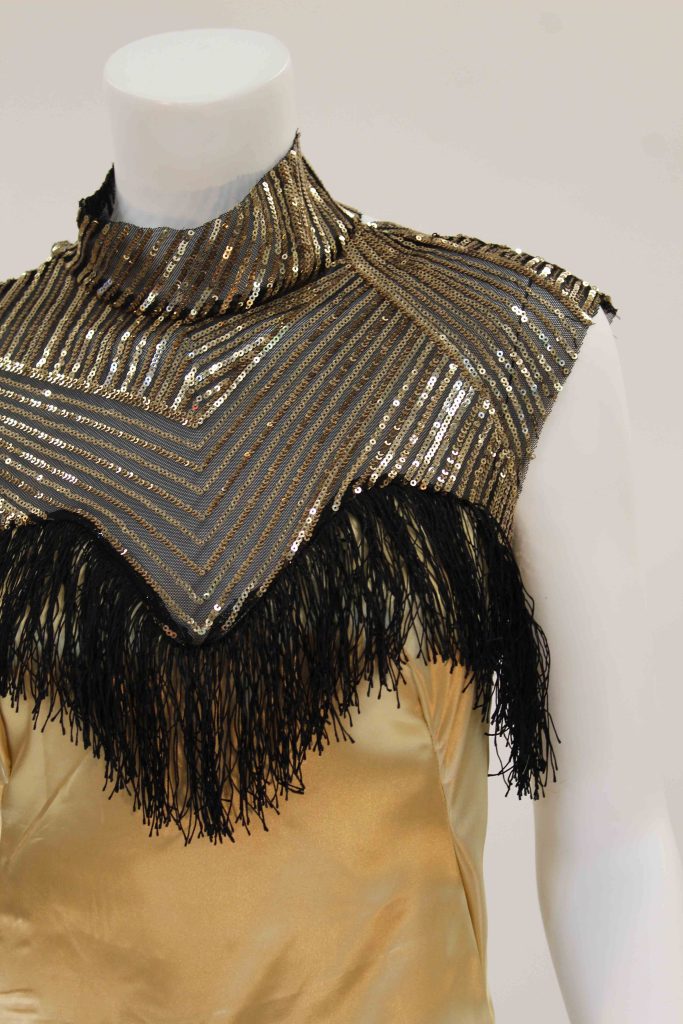
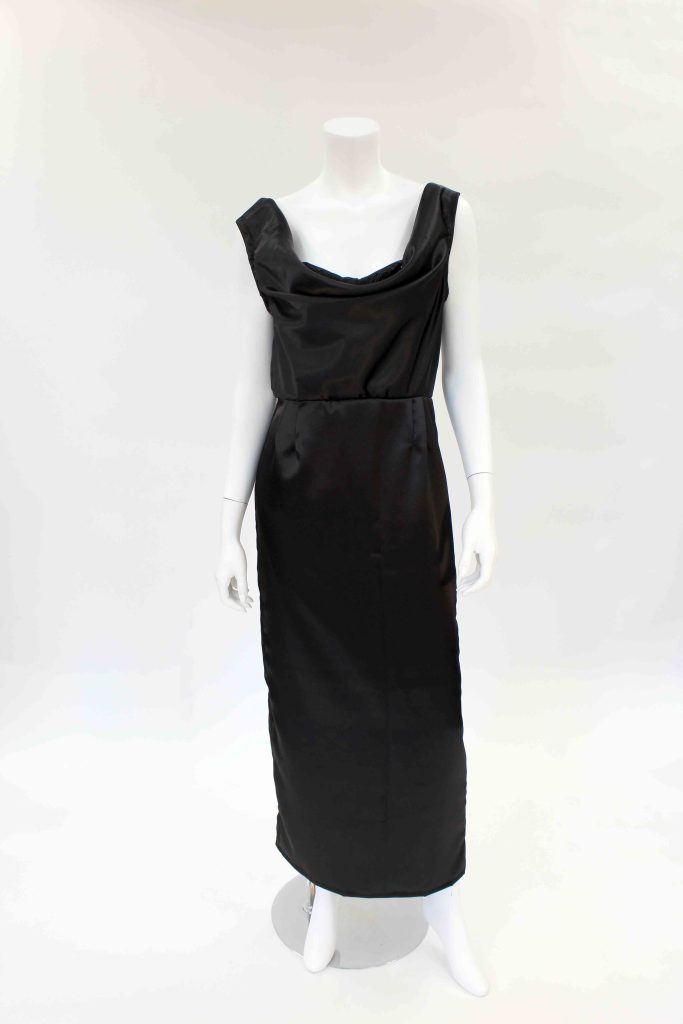
KAITLYN LYMAN Sophisticated Glamour
“Known for her glamour, grace and beauty, Ginger Rogers was a shining star in the Golden Age of Hollywood. ‘Sophisticated Glamour’ was inspired by the class and romance she so elegantly displayed as a performer. Paying ode to the style of the Golden Age, the gown also pulls inspiration from Rogers’ 1935 film “Roberta.” In the film, Rogers wears a silky black evening gown that effortlessly flows with every movement. My gown features a similar black silky fabric but with the modern twists of a cowl neckline and strapless bustier peeking through, the latter of which adds a sophisticated and feminine feel with its sequin mesh fabric. Edgy black was chosen to represent seriousness and the formal style of black-tie; the bustier top adds a scandalous feel and reflects the current trend of corset tops worn by Generation Z.
Rogers was anything but simple when it came to her wardrobe, and this gown represents her personal style in modern day. Its simplicity allows for optimal styling to fit the bold and extravagant aesthetic of Rogers’ personality.”
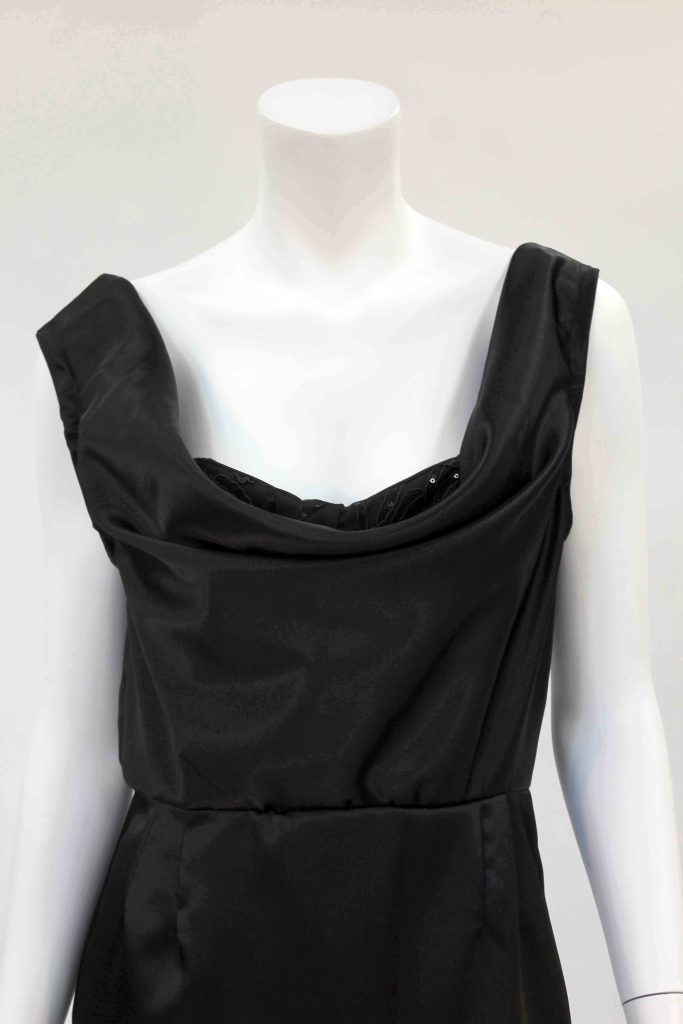
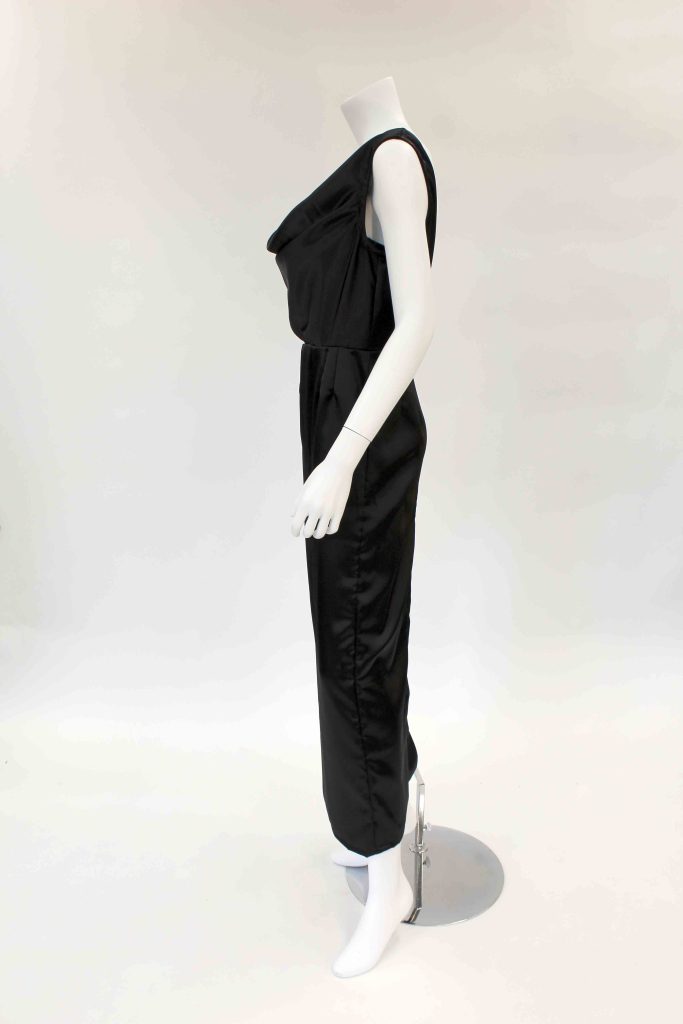
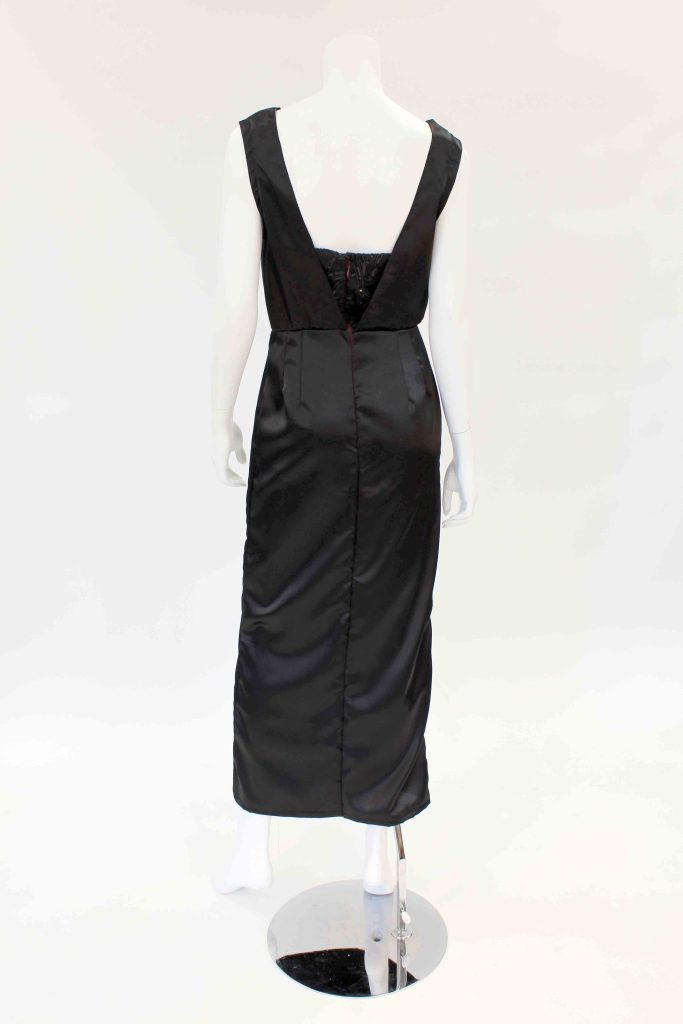
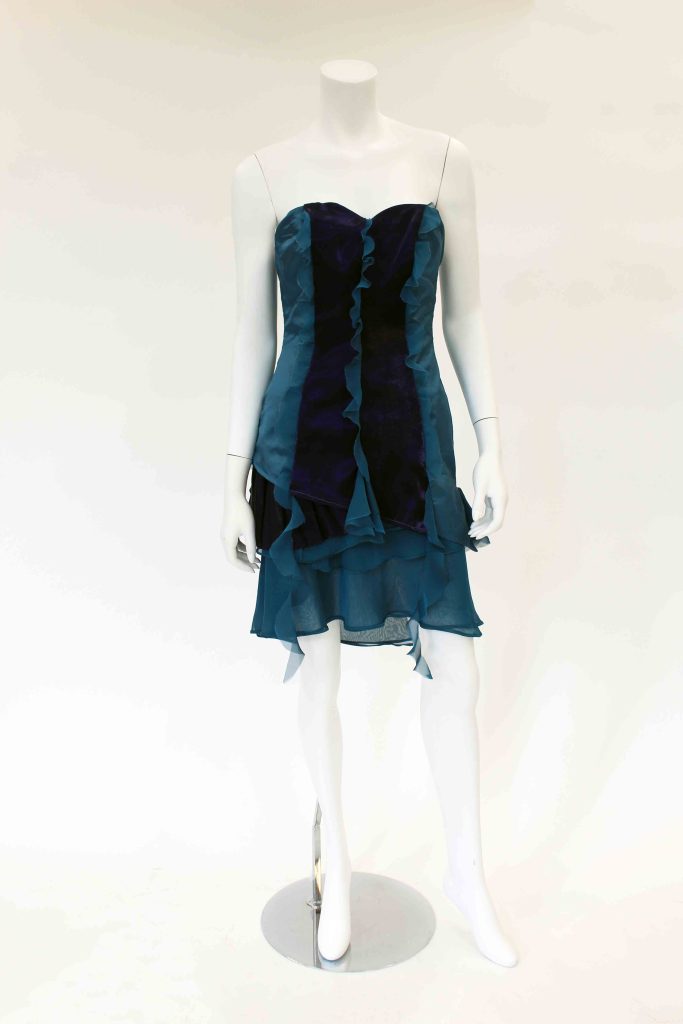
BROOKE MCKEE Ginger Rogers Through Ruffles
“Ginger Rogers has a plethora of empowering moments where she utilized her skills as a dancer to stand up against the injustices of the time. She stood strong in her dance ability and her power as a woman, never backing down. Rogers’ aesthetic vision made just as much of an impact on society as her performances themselves. Her dances with partner Fred Astaire during the 1930s were “above financial hardship,” meaning the elaborate costuming, backgrounds, and whimsical dances transported people out of reality for a moment, in this instance beyond the effects of the Great Depression. The purpose of my garment was to implement a variety of these whimsical and extravagant elements into one dress that emulates Rogers’ legacy.
Each aspect of this dress is made from vintage ballgowns to represent an historically iconic superstar by emphasizing her aesthetic roots and the importance she placed on fabric choice and construction.”
“Rogers’ career was one of allure and aesthetic for the masses, but also one of power and grit for herself. Using the material from recycled ballgowns emphasizes how much life the older fabrics still had to give and what they were able to withstand. The longevity and structural integrity of these fabrics mirrors the longevity of Rogers’ long-lasting career. Making each skirt tier a new ruffle is intended to show the diversity of performance and different costume aesthetics utilized by Rogers to enhance her show presence. The use of color is meant to enhance the visual interest of the construction details and create additional depth. The variety of ruffles flow and move in different ways, some keeping their stiff structure and others twirling around on their own. The juxtaposition of these ruffles represents Rogers’ soft yet powerful way of performing and representing herself. This dress ties together the power and beauty of Ginger Rogers’ life and work.”

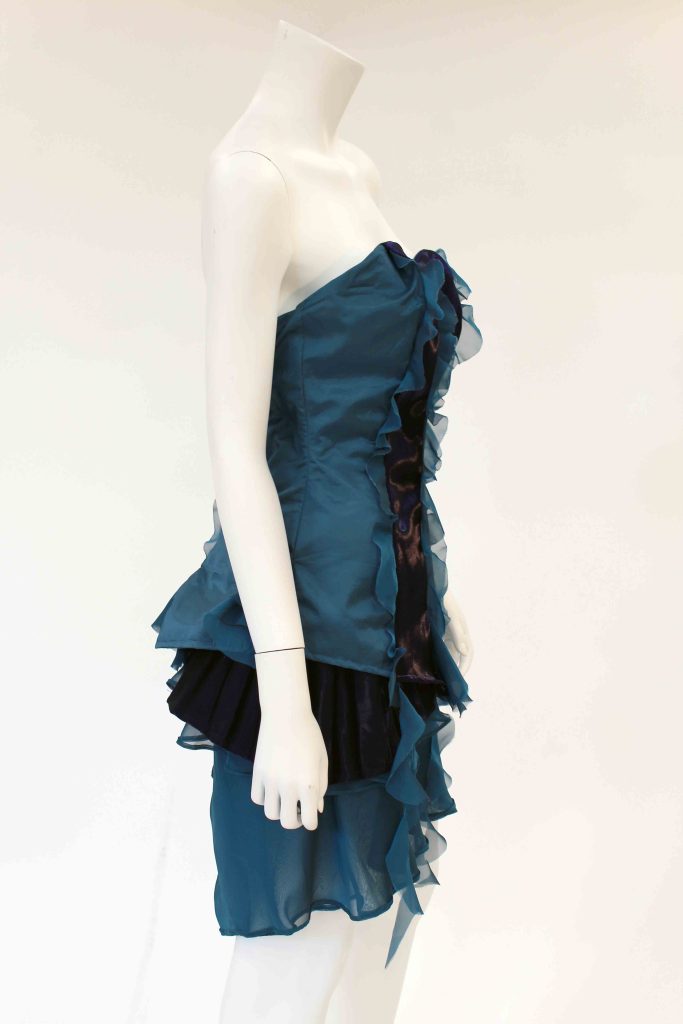
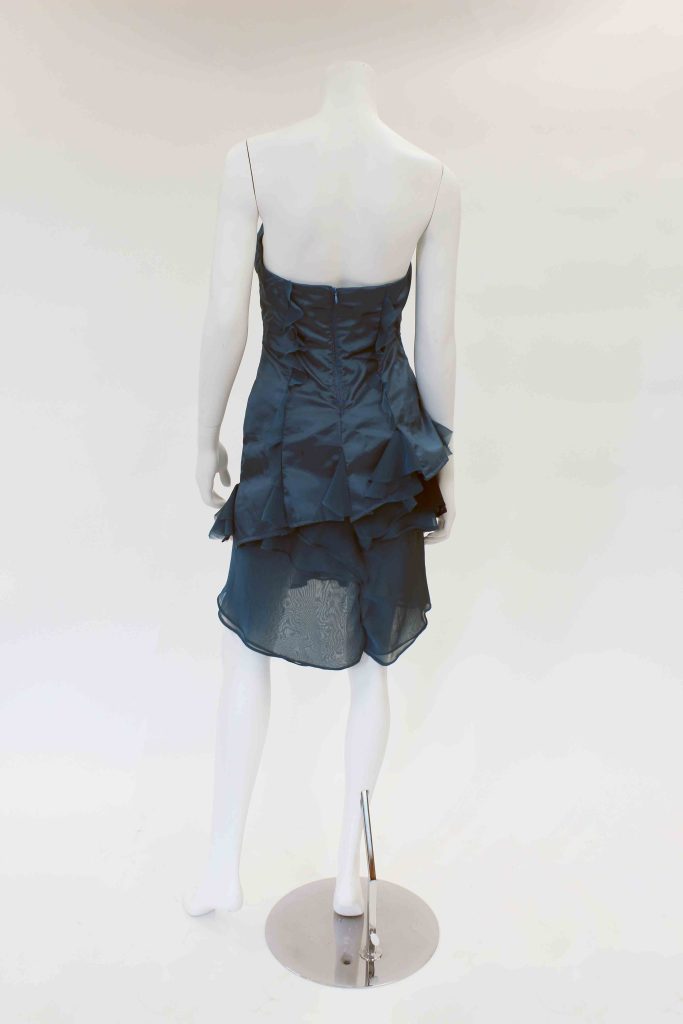

JESSICA OGBOH Oh, Hollywood
“Aside from her famous movie roles, Ginger Rogers was known for her exemplary costumes and outfits. The ensembles had to be extravagant; evening cloths had to be sheer and sparkly as movies were in black and white during the 1930s. Rogers used various elements that added movement to her costumes such as tassels, fringe, feathers, and shimmering fabrics. I chose to implement some of these characteristics highlighted in Rogers’ costumes. ‘Oh, Hollywood’ is a two-piece ensemble with corseted strapless bodice and skirt inspired by Rogers’ role as Rose Gillray, a corset salesperson, in “The First Traveling Saleslady” from 1956. The closure for the corset top incorporates grommets which are typically used on corsets. This gives the garment a vintage look as corsets were still heavily worn throughout the 1950s when “The First Traveling Saleslady” made its debut. The inspiration behind the use of different fabrics was based on the dress worn by Rogers in the popular Broadway musical “Hello, Dolly!” with its embroidered silk satin, velvet tassels, beads and sequins. The decision to use the surface texture of blue fringe-colored lace as the entire outside layer of the skirt was in homage to the famous blue feather dress Ginger wore in “Top Hat” (1935).”

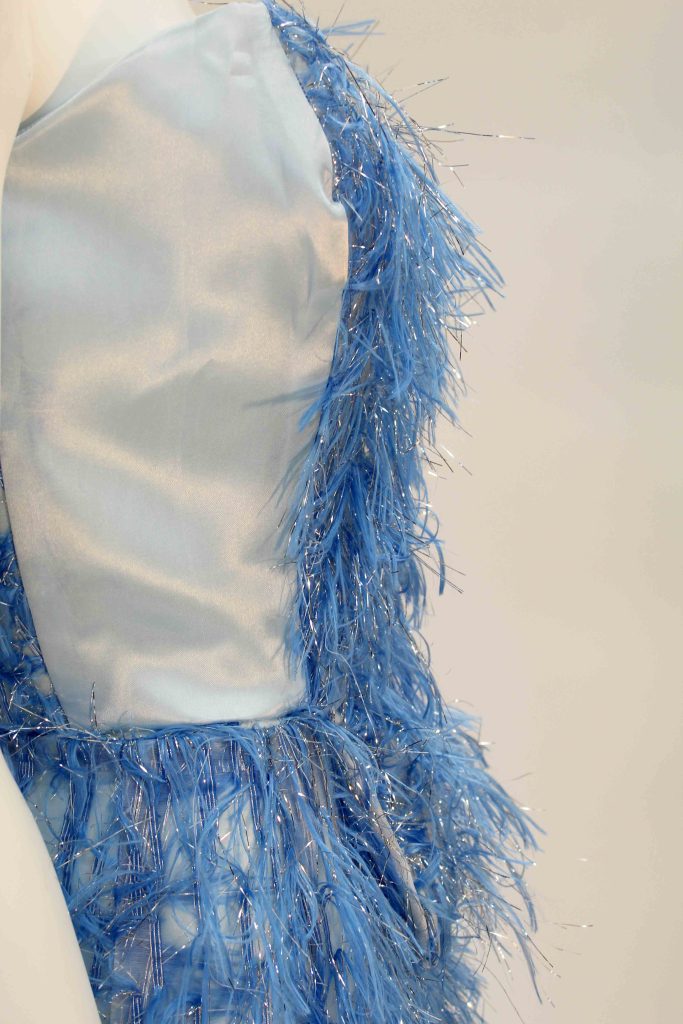
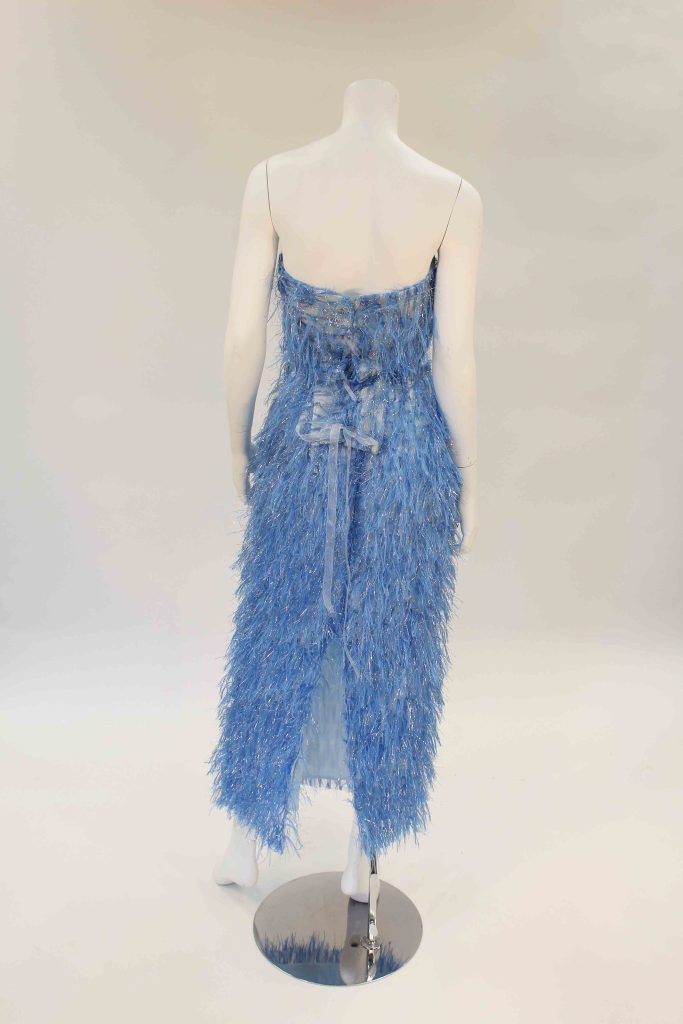

ALYSSA PIERSON The Golden Age
“Ginger Rogers was a glamourous Hollywood actor who expressed her femininity and personality in her costumes. The dress I created represents the elegance in her dress. I took elements from her dress in “Swing Time” (1936) such as its triangular waistline insert to reflect the Art Deco aesthetic of the period and its godets to add fullness and at the bottom of the long skirt, a common theme for Rogers as she loved to swing around in full skirts as she danced.
Rogers’ 1938 film “Vivacious Lady” also inspired my gown’s triangular and flowy elements, as well as its sparkle. Lastly, the open back of Rogers’ blue feather dress from “Top Hat” (1935), one of her signature looks, inspired me, as well. Emulating her glamorous Old Hollywood aesthetic, I wanted to create an elegant evening gown that Rogers would wear. I selected a champagne gold shade for the dress, accenting it with sparkling sequins, and adding a floating train of shimmering gold tulle. The dress emulates elegance with the fabric flowing down to the floor while the gold creates an expensive look. Creating a dress inspired by Ginger Rogers was quite a process because there were so many directions one could go. In the end, creating a dress that was elegant but still displayed Ginger’s extravagant style was the goal I chose.”
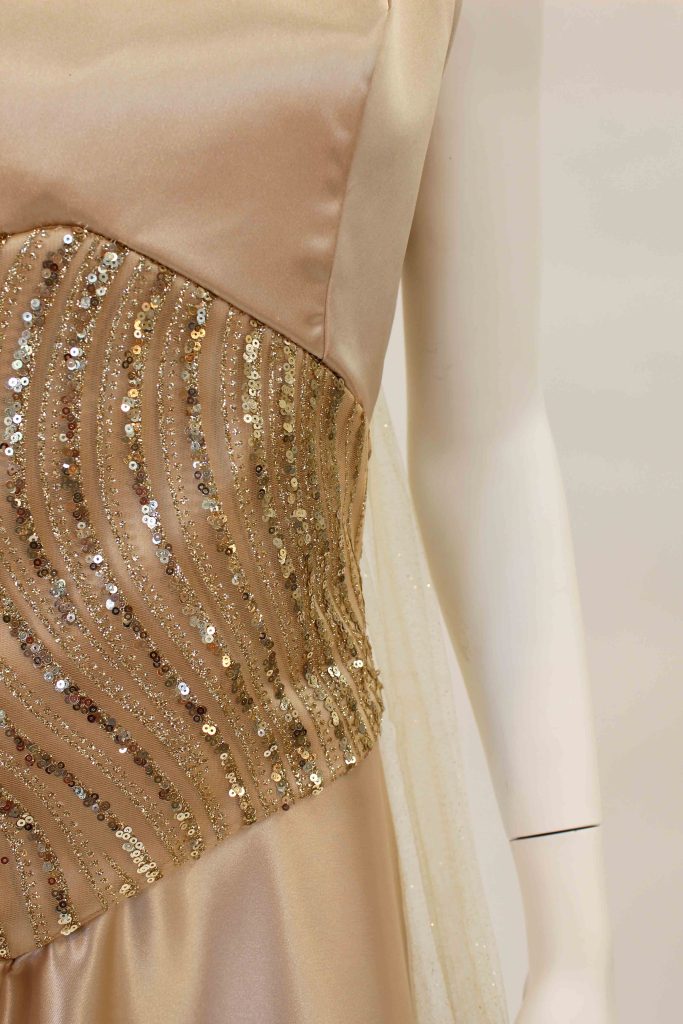

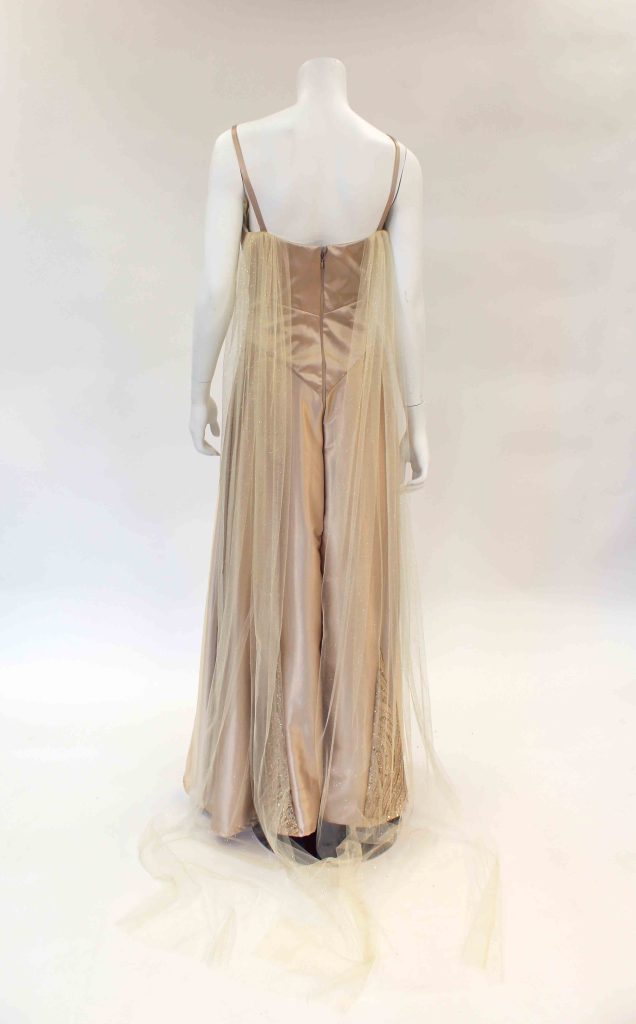
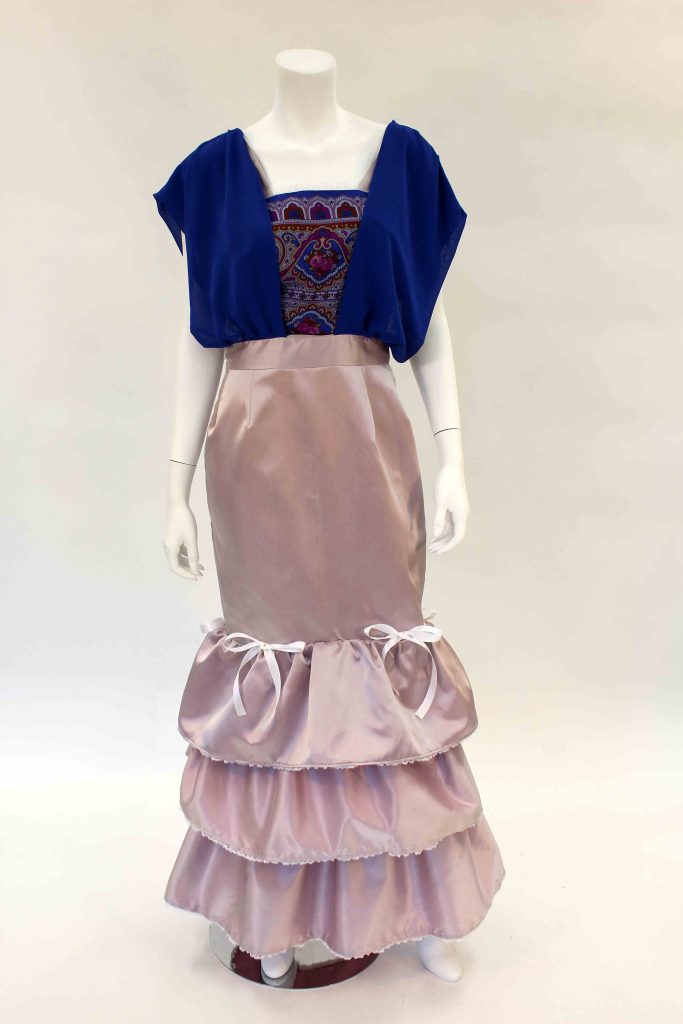
HANNAH RETTKE Dancing Alone
“Ginger Rogers is a Hollywood icon whose fierce temperament and acting and dancing skills helped her excel in her career. Had Rogers not been so ambitious, she might have settled for lasting fame as Fred Astaire’s most popular dance partner. Ultimately, she wanted more for herself and in a courageous career move, broke off her partnership with Astaire to pursue a solo career. When tasked with designing a look for such an iconic woman, I wanted to create a modern look that captured the fierce new direction she presented in her career, utilizing draping methods, colors and fabrics that embodied her personality. ‘Dancing Alone: Ginger Rogers’ takes influence from the popular construction methods of the 1930s to take an ordinary look and elevate it to something extraordinary.
Her blue ostrich feather dress from “Top Hat” (1935) is one of most notable looks; I wanted to incorporate the extravagant vibe of the feather dress but opt for softer trimmings including lace and pearls. Layering and utilizing bold colors and detailing was essential to curate the perfect Ginger Rogers inspired gown.”


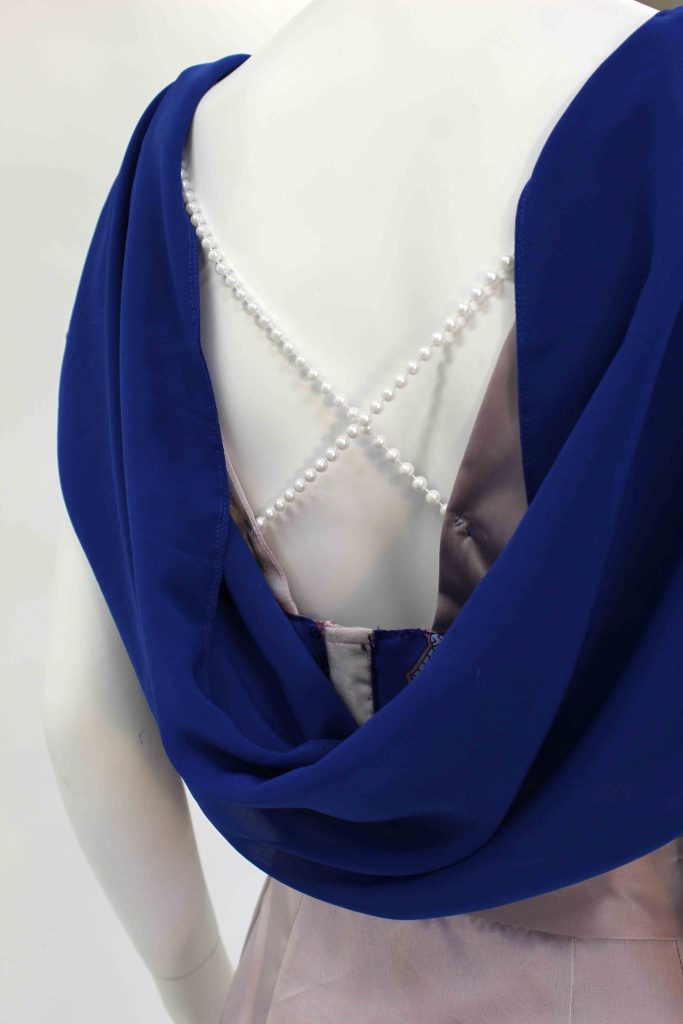
“Fabrics, colors, trimmings, and draping techniques were carefully selected to convey an aesthetic approach to the youthful side of Roger’s career. ‘Dancing Alone’ honors her career as a performer by creating a look that is acceptable in a modern setting but also features closures and finishing details present in Rogers’ former looks. The meanings of the trims and colors challenge the typical sentiment of the looks – feathers and the color pink – often associated with Rogers’ career. I also wanted to dive deeper into who Rogers was instead of creating something too predictable, such as common slinky, bias-cuts and full gowns with feathers. Lace and bow trims play on a more youthful side; the bold color pattern of royal blue and light purple showcase colors other than her usual pink to encompass a look made for a bold, fierce, and independent woman. The perfect dress in which to dance alone.”